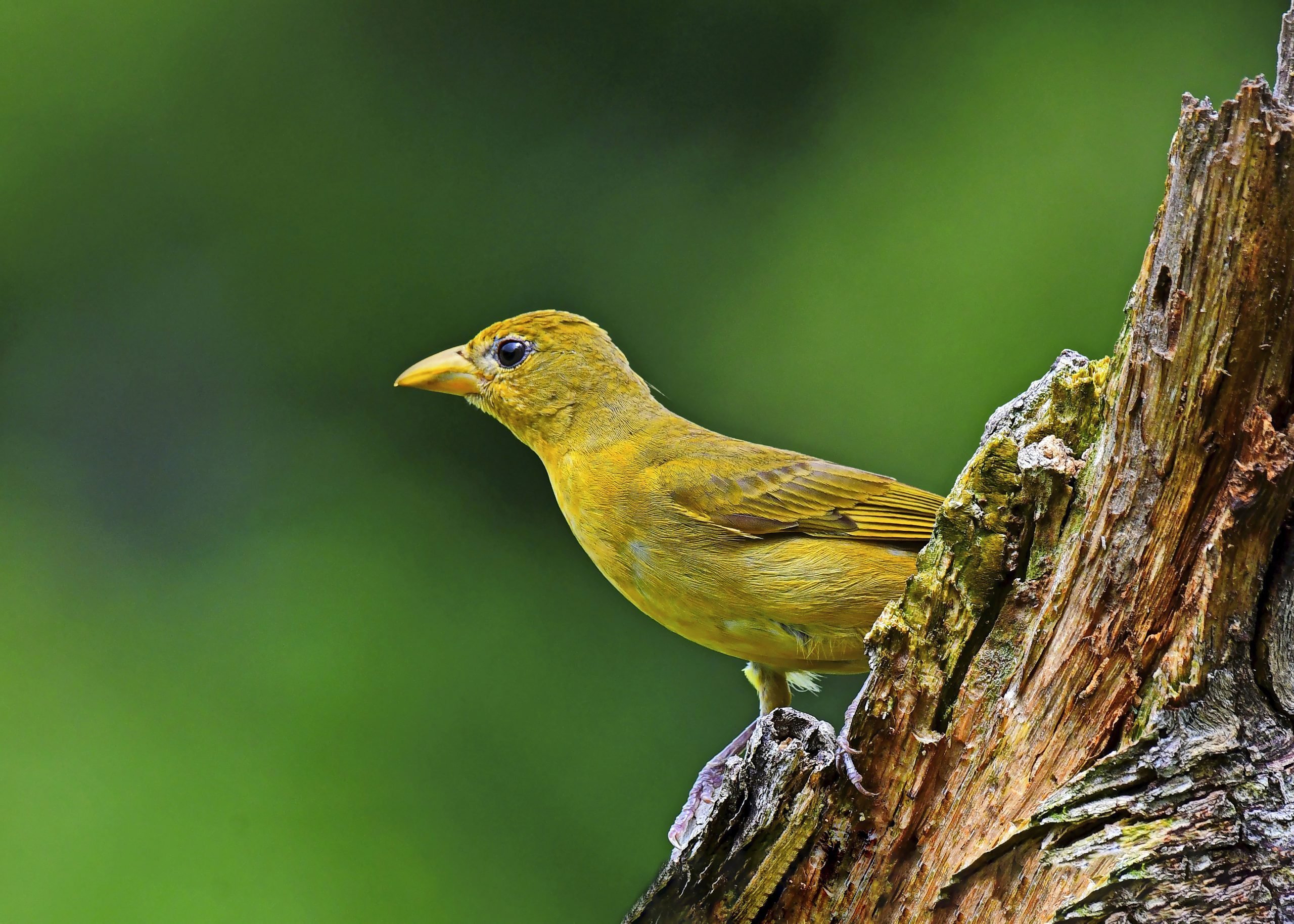Yellow birds are frequently seen throughout the year in Alabama due to its warm climate. Orioles, tanagers, and warblers are common during spring and summer, while other warblers and American Goldfinch migrate to the region during winter.
To assist in identifying these yellow birds in Alabama, this guide provides pictures, identification information, song recordings, and migration patterns.
The majority of yellow birds found in Alabama are warblers, orioles, or tanagers, and sometimes the female birds of these species exhibit distinct differences from their male counterparts.
With the comprehensive information provided in this guide, identifying yellow birds in Alabama becomes much easier. The following list presents the most commonly spotted yellow birds in the state during spring and summer (May and June), based on ebird checklists:
Yellow birds in Alabama throughout the year: Pine Warbler, Eastern Meadowlark
Yellow birds in Alabama during summer: White-eyed Vireo, Summer Tanager, Common Yellowthroat, Hooded Warbler, Yellow-throated Vireo, Orchard Oriole, Prothonotary Warbler, Prairie Warbler, Yellow-throated Warbler, Dickcissel
Yellow birds in Alabama during winter: Yellow-rumped Warbler, American Goldfinch, Cedar Waxwing, Palm Warbler, Orange-crowned Warbler, Baltimore Oriole, Painted Bunting, Western Kingbird, Evening Grosbeak
Yellow birds in Alabama during migration: American Redstart, Scarlet Tanager, Magnolia Warbler, Black-throated Green Warbler, Yellow Warbler, Blue-winged Warbler, Cape May Warbler, Canada Warbler, Nashville Warbler, Wilson’s Warbler
Accidental Yellow birds in Alabama: Western Tanager, Yellow-headed Blackbird, Lesser Goldfinch, Hooded Oriole, Western Meadowlark, Couch’s Kingbird
Continue reading to learn how to identify the yellow birds you’ve spotted.
37 Yellow Birds in Alabama:
1. Yellow-rumped Warbler
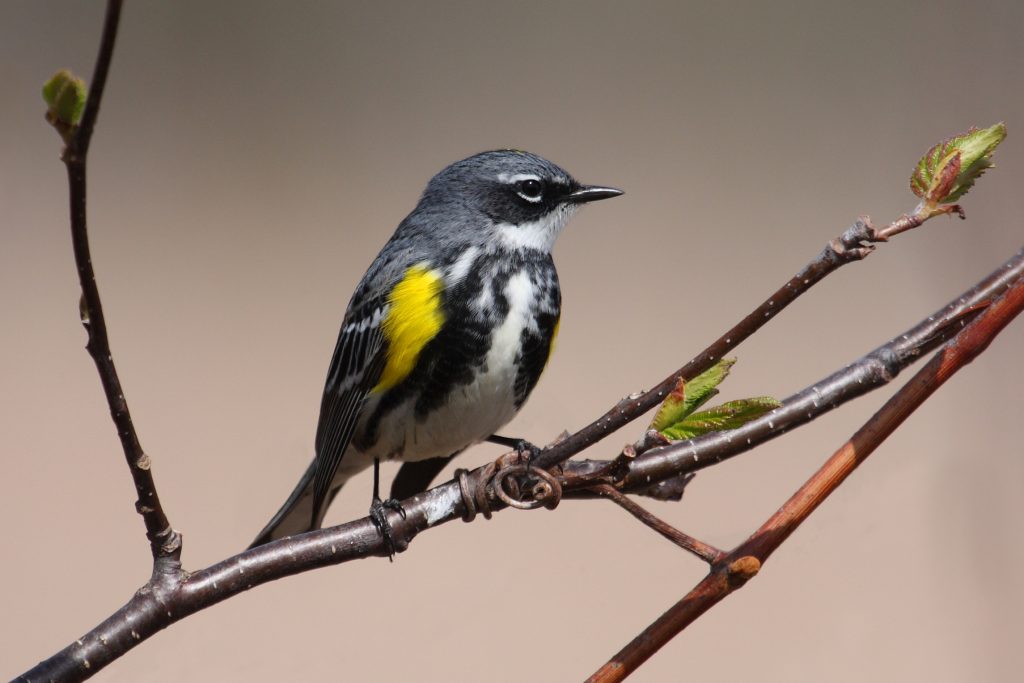
Yellow-rumped Warblers are winter visitors to Alabama, arriving in September and staying until May. The best months to spot them are from October to April. Approximately 32% of winter checklists submitted by birdwatchers in the state record their sightings.
Yellow-rumped Warblers have a gray body with flashes of yellow on the face, sides, and rump, as well as white wings. Females may appear slightly brown, while winter birds exhibit a paler brown color with bright yellow rumps and sides that transition back to yellow and gray during spring.
Scientific name: Setophaga coronata
Length: 4.7-5.5 inches (12-14 cm)
Weight: 0.4-0.5 ounces (12-13 g)
Wingspan: 7.5-9.1 inches (19-23 cm)
Yellow-rumped Warblers predominantly breed in Canada, the Rockies, and the Appalachian mountains. During migration, they can be seen in the Midwest before overwintering in southern and southwestern US states, the Pacific Coast, Mexico, and Central America.
These warblers are commonly found in coniferous forests during the breeding season and open areas with fruiting shrubs during winter. Their diet consists mainly of insects in summer and during migration, while in winter, they primarily feed on fruit such as bayberry and wax myrtle.
Listen to the Yellow-rumped Warbler song:
Nests of Yellow-rumped Warblers are constructed by females using twigs, pine needles, and grass. The nests are lined with soft grass, moss, and hair. The females lay up to six eggs, which hatch after approximately two weeks. The young birds leave the nest about two weeks later.
Attract Yellow-rumped Warblers to your backyard by providing sunflower seeds, suet, raisins, and peanut butter.
Fun Fact: Yellow-rumped Warblers form large flocks during winter, and they can display aggression towards other species that come too close.
2. Pine Warbler
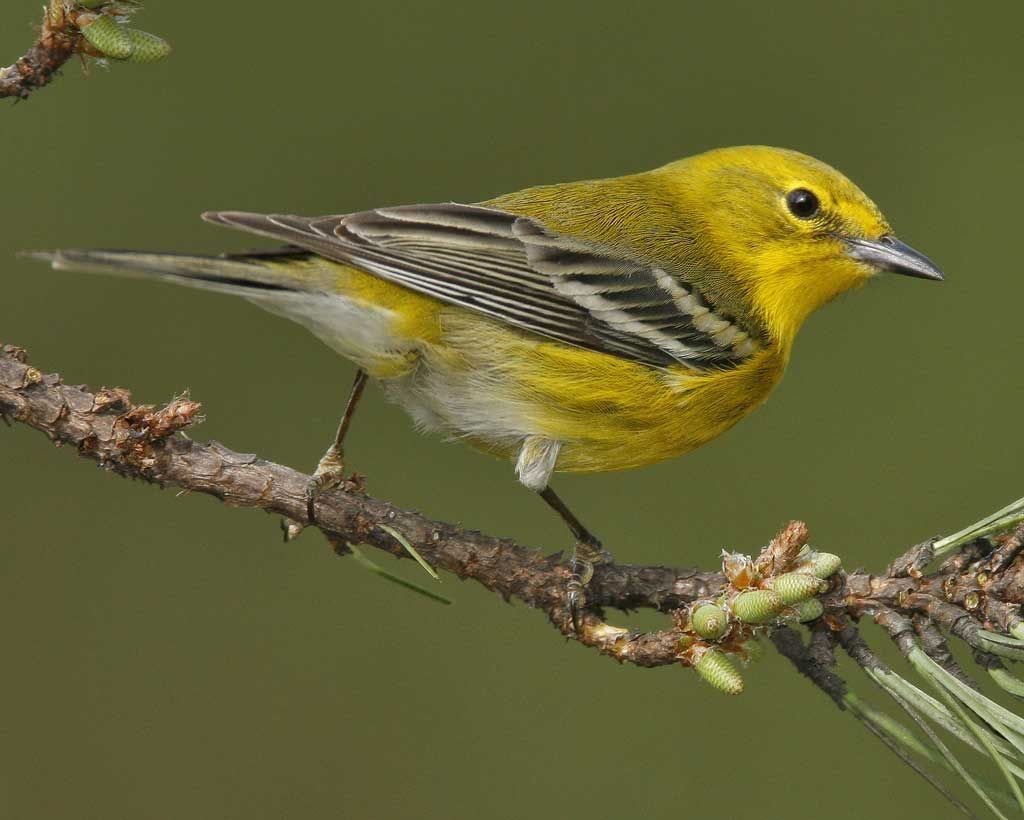
Pine Warblers can be spotted year-round in Alabama. They are found in approximately 15% of summer checklists and 20% of winter checklists submitted by birdwatchers in the state.
Pine Warblers are small, plump yellow birds with olive-colored backs, white lower bellies, and gray wingbars. Females may appear slightly browner and have more white on their bellies.
Scientific name: Setophaga pinus
Length: 5.1-5.5 inches (13-14 cm)
Weight: 0.3-0.5 ounces (9-15 g)
Wingspan: 7.5-9.1 inches (19-23 cm)
Pine Warblers breed in northeastern US states before migrating to southeastern US states. Some individuals remain in the southeastern states throughout the year.
These warblers are commonly found in pine forests, as their name suggests, often high up in the trees. They primarily feed on caterpillars, beetles, spiders, and other insects and larvae. In colder weather, they also consume fruit and seeds.
Listen to the Pine Warbler song:
Nests of Pine Warblers are typically built in pine trees. They are constructed from twigs, bark, pine needles, and grass, bound together with spider silk. The nests are lined with feathers and animal hair. Pine Warblers lay up to five eggs, which hatch after approximately two weeks. The young birds leave the nest around ten days later.
Attract Pine Warblers to your yard by using tube feeders and platform feeders with millet, cracked corn, sunflower seeds, peanut hearts, and suet. Additionally, consider planting native fruit-bearing plants and vines like bayberry, grape, sumac, and Virginia creeper.
Fun Fact: Pine Warblers are one of the few warbler species that primarily feed on seeds, making them more likely to visit backyard feeders.
3. American Goldfinch

American Goldfinches are predominantly observed during winter in southern Alabama, although some individuals remain in the northern part of the state all year. They are present in approximately 9% of summer checklists and 27% of winter checklists.
American Goldfinches are popular birds, especially during spring when males display their bright yellow and black plumage. Females and winter males exhibit a duller brown coloration.
Scientific name: Spinus tristis
Length: 4.3-5.1 inches (11-13 cm)
Weight: 0.4-0.7 ounces (11-20 g)
Wingspan: 7.5-8.7 inches (19-22 cm)
American Goldfinches can be found in most parts of North America and are typically year-round residents. However, individuals that breed in Canada and the Midwest migrate to southern US states for winter.
These goldfinches inhabit weedy fields, overgrown areas, suburbs, parks, and backyards. Their diet primarily consists of seeds from sunflowers, thistles, and aster plants. They also visit bird feeders and have a preference for sunflower and nyjer seeds.
Listen to the American Goldfinch song:
Nests of American Goldfinches are usually located in shrubs and constructed from rootlets and plant material woven together. The nests are secured to branches using spider webs. Females lay up to seven eggs, which hatch after approximately two weeks. It takes an additional two to two and a half weeks for the young birds to leave the nest.
Attract American Goldfinches to your backyard by planting thistles and milkweed. They will visit various bird feeders and particularly enjoy sunflower and nyjer seeds.
Fun Fact: Cowbirds have no success in getting American Goldfinches to raise their young, as the goldfinches’ exclusively vegetarian diet is unsuitable for cowbird chicks, causing their demise within a few days.
4. White-eyed Vireo
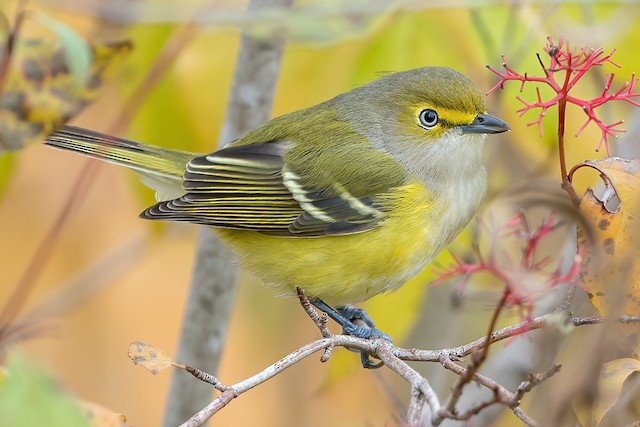
White-eyed Vireos are present in Alabama during the breeding season, primarily from April to October. They are found in approximately 22% of summer checklists. A few individuals remain in the southern part of the state throughout the year.
White-eyed Vireos have gray heads with yellow coloration around their foreheads and distinct white eyes. They exhibit white chests and throats, yellow sides, greenish backs with darker wings, and two white wingbars.
Scientific name: Vireo griseus
Length: 4.3-5.1 inches (11-13 cm)
Weight: 0.3-0.5 ounces (10-14 g)
Wingspan: 6.7 inches (17 cm)
White-eyed Vireos spend their summers across the southeastern United States, often hidden within thickets. Some individuals remain in coastal areas year-round, while others migrate to the southeast coast of Mexico and the Caribbean for winter.
These vireos are commonly found in overgrown pastures, brambles, and areas with thick vegetation. They feed on insects, flies, and spiders, and during winter, they also consume berries.
Listen to the White-eyed Vireo song:
Nests of White-eyed Vireos hang from branches in shrubs. Females use spiders’ webs to create the initial shape and then add leaves, bark, and plant material to form a hanging cup-shaped nest.
They lay around four eggs, which hatch after approximately two weeks. The young birds leave the nest around ten days later.
Fun Fact: In winter, both male and female White-eyed Vireos sing. However, during spring and summer, only the males sing extensively from dawn until midday.
5. Summer Tanager (Female)
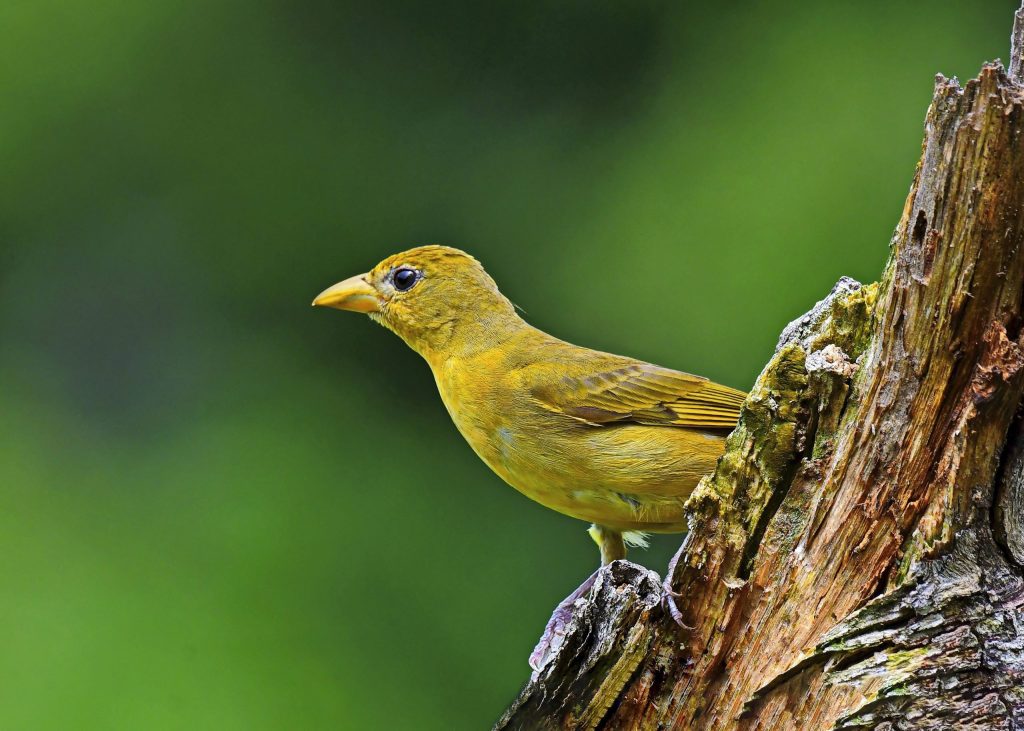
Summer Tanagers are frequently seen in Alabama during the breeding season from April to October. They appear in approximately 18% of checklists during this time.
Male Summer Tanagers are bright red with chunky beaks, while females and juveniles exhibit mainly yellow coloration with hints of green on their backs.
Scientific name: Piranga rubra
Length: 6.7 inches (17 cm)
Weight: 1.1 ounces (30 g)
Summer Tanagers breed in southern and eastern states before migrating to Central and South America for winter.
These tanagers are commonly found in open woodlands, where they feed on bees and wasps in mid-flight. They catch their prey, kill them by beating them against a branch, and remove the stingers before consuming them.
Listen to the Summer Tanager song:
Nests of Summer Tanagers are built by females using grass and other plant materials. The nests are typically situated at the end of overhanging branches. While the nests may not be well-constructed, they can hold around four eggs. The eggs hatch in approximately ten days, and the young birds leave the nest after another ten days.
Attract Summer Tanagers to your backyard by planting berry bushes and fruit trees.
Fun fact: Young Scarlet Tanagers are fed by their parents for an additional three weeks after leaving the nest, as they have limited flying capabilities during that period.
6. Cedar Waxwing
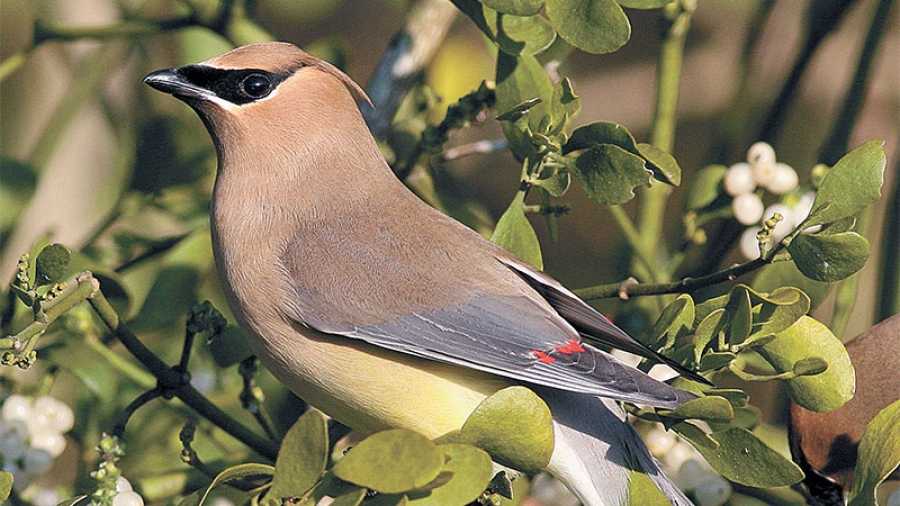
Cedar Waxwings are primarily observed in Alabama during winter, with sightings occurring from mid-September until May. They are recorded in approximately 11% of checklists during this period.
Cedar Waxwings are elegant and sociable birds with pale brown heads, chests, and crests that fade to gray on their backs and wings. Their bellies are pale yellow, and their tail tips feature bright yellow accents. They also possess a narrow black mask over their eyes and bright red wingtips.
Scientific name: Bombycilla cedrorum
Length: 5.5-6.7 inches (14-17 cm)
Weight: 1.1 ounces (32 g)
Wingspan: 8.7-11.8 inches (22-30 cm)
Cedar Waxwings breed in Canada before migrating to the southern United States, Mexico, and Central America for winter. They are year-round residents in northern US states.
These waxwings can be found in berry bushes, woodlands, grasslands, towns, and along streams. Their diet mainly consists of fruit, although they also consume insects during the summer.
Listen to the Cedar Waxwing call:
Nests of Cedar Waxwings are constructed in trees using twigs, grass, hair, and plant materials. The nests are lined with pine needles and soft grass. Females lay up to six eggs, which hatch after around twelve days. The young birds leave the nest after approximately sixteen days.
Attract Cedar Waxwings to your backyard by planting native trees and shrubs that bear small fruits, such as serviceberry, dogwood, juniper, winterberry, and hawthorn. You can also try offering fruit on platform feeders.
Fun Fact: Cedar Waxwings engage in a unique behavior during courtship, where they exchange gifts by passing objects between them.
7. Common Yellowthroat
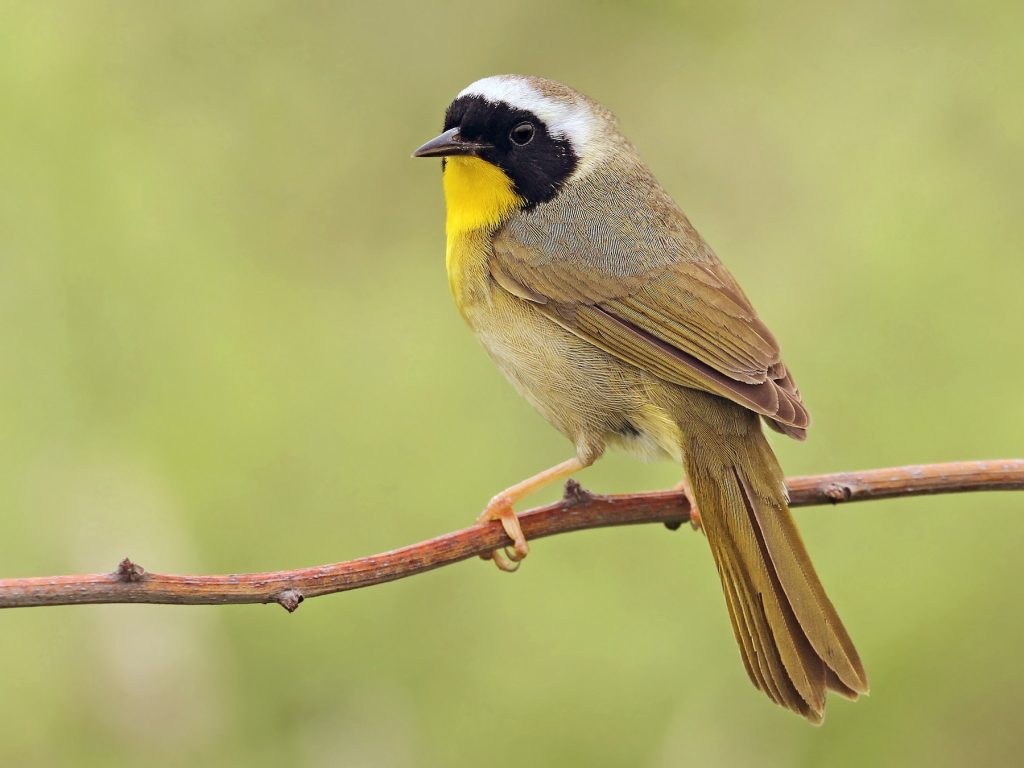
Common Yellowthroats can be spotted year-round in southern Alabama, although they are more commonly seen in the northern part of the state during the breeding season. They are present in approximately 9% of summer checklists and 2% of winter checklists.
Common Yellowthroats are small songbirds with brownish backs and bright yellow underparts, featuring long tails. Males have black masks across their faces. The intensity of their yellow coloration can vary geographically, and some individuals may appear more olive-colored underneath.
Scientific name: Geothlypis trichas
Length: 4.3-5.1 inches (11-13 cm)
Weight: 0.3-0.3 ounces (9-10 g)
Wingspan: 5.9-7.5 inches (15-19 cm)
Common Yellowthroats breed across most of North America, excluding Alaska and northern Canada. Some individuals remain year-round along the Gulf Coast and the Pacific Southwest. During winter, they migrate south.
These yellowthroats are often found in marshy or wetland areas and brushy fields, taking shelter amidst dense, tangled vegetation.
Listen to the Common Yellowthroat song:
Nests of Common Yellowthroats are built by females near the ground in marshy areas. The nests are supported by reeds and constructed from grass, sedges, and plant materials woven into a cup shape. They lay up to six eggs, which hatch after around twelve days. The young birds leave the nest after a similar duration.
Attract Common Yellowthroats to larger backyards with dense vegetation and native plants that attract insects.
Fun Fact: The black mask of Common Yellowthroats serves as a signal to male courting birds. They exhibit aggressive behavior towards artificial birds with masks but not towards those without masks.
8. Eastern Meadowlark
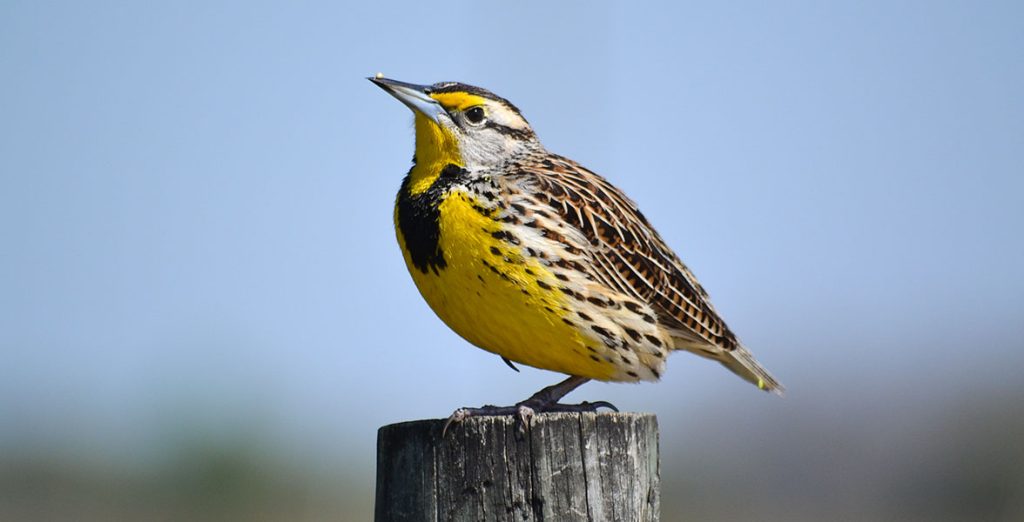
Eastern Meadowlarks are considered a near-threatened species. However, they can be
spotted year-round in Alabama, present in approximately 9% of summer checklists and 5% of winter checklists.
Eastern Meadowlarks are medium-sized songbirds with bright yellow underparts and pale brown bodies adorned with black markings on the back. They feature a distinct black band across the chest.
Scientific name: Sturnella magna
Length: 7.5-10.2 inches (19-26 cm)
Weight: 3.2-5.3 ounces (90-150 g)
Wingspan: 13.8-15.8 inches (35-40 cm)
Eastern Meadowlarks are found throughout eastern US states all year, with additional breeding populations in the Northeast and Canada. They migrate south for winter.
Spring arrives in the East with the melodious songs and displays of Eastern Meadowlarks, but unfortunately, their population is now considered near-threatened.
These meadowlarks can be found on the ground in grasslands and prairies, where they primarily feed on insects. During winter, they gather in large flocks in fields, searching for seeds.
Eastern Meadowlark sounds: They produce clear and melodious flute-like whistles.
Listen to the Eastern Meadowlark sounds:
Nests of Eastern Meadowlarks are constructed on the ground and often exhibit remarkable structures, including tunnels and woven grass roofs. They are made from grasses, twigs, and animal hair. Eastern Meadowlarks lay up to six eggs.
Fun Fact: Eastern Meadowlarks are capable of singing more than 100 different songs.
9. Hooded Warbler

Hooded Warblers breed in Alabama and can be observed from March until mid-November. They are present in approximately 9% of summer checklists.
Male Hooded Warblers exhibit a bright yellow face with a distinctive black hood and throat. They have yellow underparts and olive-green upperparts. The under-tail is white, visible when they flick their tails upward. Females and immatures are more yellow in appearance and lack the black face markings.
Scientific name: Setophaga citrina
Length: 5.1 inches (13 cm)
Weight: 0.3-0.4 ounces (9-12 g)
Wingspan: 6.9 inches (17.5 cm)
Hooded Warblers breed in eastern US states before migrating south to Central America and the Caribbean for winter.
These warblers are commonly found in forests with dense understories, where they hunt for insects and spiders.
Listen to the Hooded Warbler song:
Nests of Hooded Warblers are built near forests and clearings, usually in shrubs. They are woven from bark, grass, and plant materials into a cup shape. The nests are lined with soft grass, feathers, and animal hair. Hooded Warblers lay around four eggs, which hatch after approximately twelve days. The young birds leave the nest after a further nine days.
Attract Hooded Warblers to your backyard by providing native shrubs and plants that attract insects and offer protective cover.
Fun Fact: Hooded Warblers possess white spots on their tails, which are believed to startle insects, making them easier to catch.
10. Palm Warbler
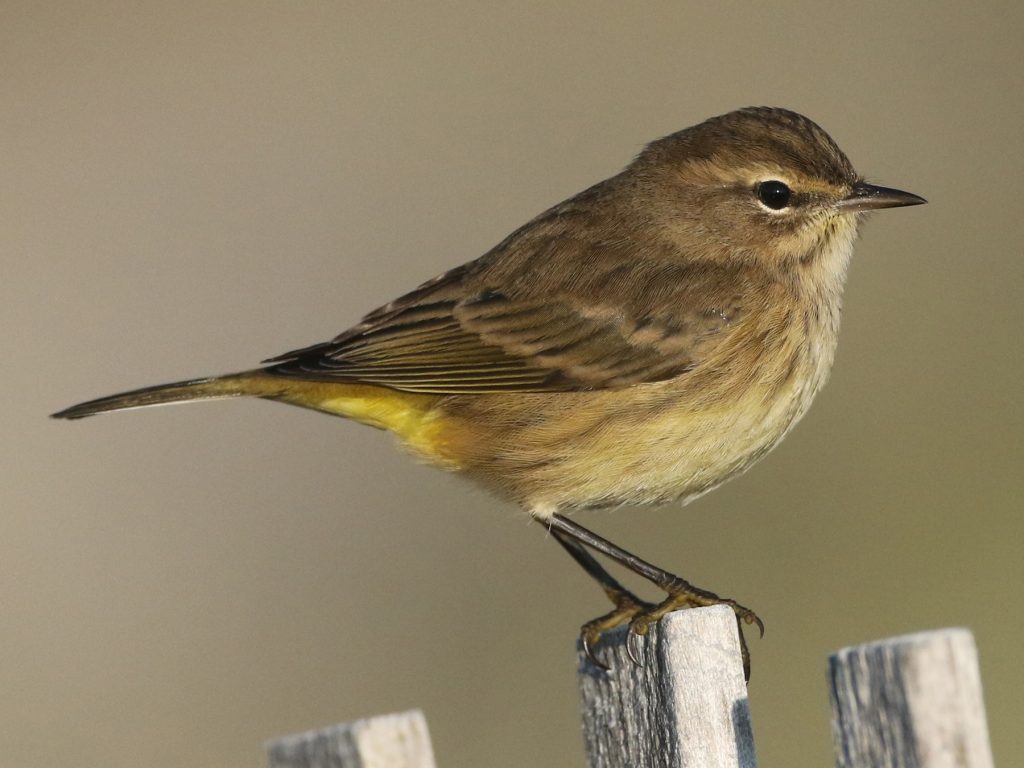
Palm Warblers can be seen in southern Alabama during winter, but their numbers increase during their migration in April and October. They are recorded in approximately 4% of winter checklists and up to 15% of checklists during migration.
Palm Warblers have a rusty red patch on the top of their heads and display a browny-olive coloration across the rest of their bodies. They breed in Canada and can be found in eastern US states during migration. They also occur year-round along
the far southern coast and Florida.
Scientific name: Setophaga palmarum
Length: 4.7-5.5 inches (12-14 cm)
Weight: 0.3-0.5 ounces (7-13 g)
Wingspan: 7.9-8.3 inches (20-21 cm)
Palm Warblers predominantly breed in Canada and can be observed during migration in eastern US states. Some individuals winter in Florida and along the southeastern coast.
These warblers are often spotted during spring and fall migrations in weedy fields, forest edges, and scrubby areas. They frequently forage on the ground for insects, alongside other bird species such as sparrows, juncos, and yellow-rumped warblers.
Palm Warbler song: Listen to the Palm Warbler song:
Nests of Palm Warblers are situated in bogs and boreal forests on the ground. They are constructed from grass, sedge, and ferns, woven into a cup shape and lined with soft grass, feathers, and animal hair. Palm Warblers lay around five eggs.
Attract Palm Warblers to your backyard by planting native plants that attract insects. Consider adding bayberry or hawthorn bushes for their berries.
Fun Fact: Unlike most warbler species, Palm Warblers often walk on the ground, bobbing their tails while searching for insects.
11. Orange-crowned Warbler
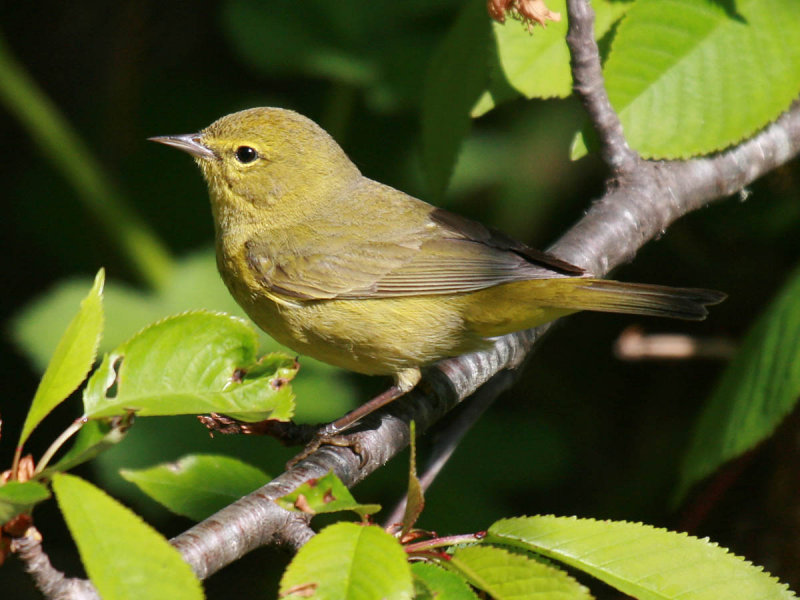
Orange-crowned Warblers can be spotted in Alabama during migration, particularly in the spring and fall. They are recorded in approximately 7% of checklists during these periods.
Orange-crowned Warblers have a predominantly olive-green plumage with a faint hint of orange on their crowns, which is often hidden. They are relatively plain-looking warblers compared to others.
Scientific name: Leiothlypis celata
Length: 4.7-5.1 inches (12-13 cm)
Weight: 0.3-0.4 ounces (8-11 g)
Wingspan: 7.5-8.7 inches (19-22 cm)
Orange-crowned Warblers breed in the northern parts of North America and Canada. They migrate through various US states, including Alabama, during their spring and fall journeys.
These warblers can be found in a variety of habitats, including forests, woodlands, and shrubby areas. They primarily feed on insects and spiders.
Listen to the Orange-crowned Warbler song:
Nests of Orange-crowned Warblers are typically placed on the ground, hidden in dense vegetation. They are constructed from grasses, twigs, and other plant materials, forming a cup-shaped nest. The female lays around four eggs, which hatch after approximately two weeks. The young birds leave the nest around ten days later.
12. Baltimore Oriole
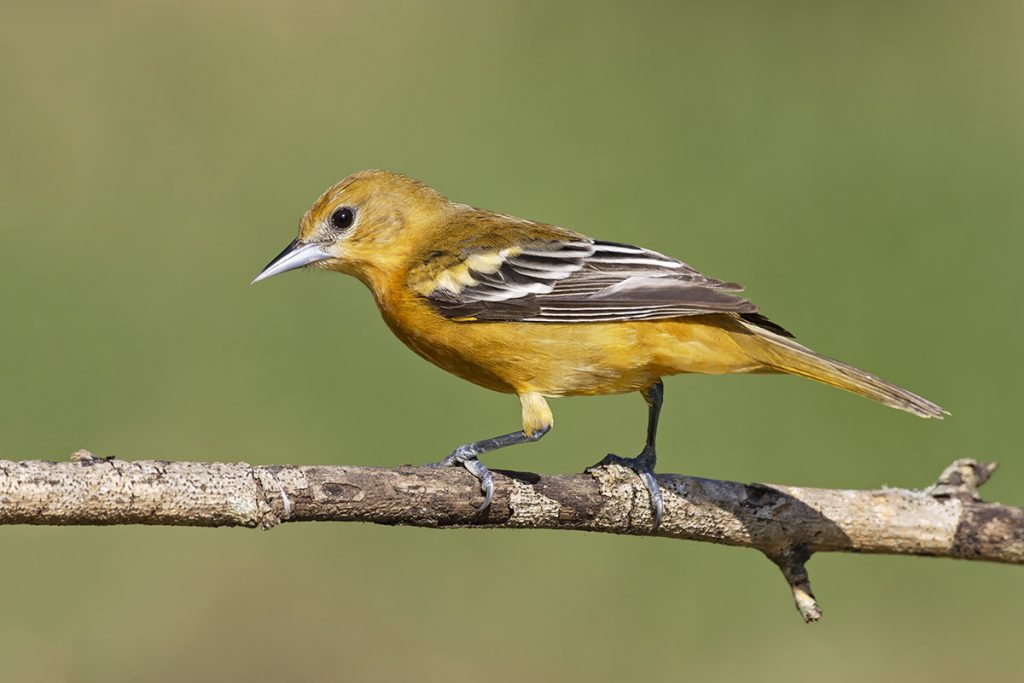
Galveston Co., TX
May 2005
Baltimore Orioles can be spotted in Alabama during winter and migration. They are recorded in approximately 8% of winter checklists and 6% of checklists during migration.
Male Baltimore Orioles are striking birds with vibrant orange plumage and contrasting black wings and heads. Females have a more subdued yellowish-orange coloration.
Scientific name: Icterus galbula
Length: 6.7-7.5 inches (17-19 cm)
Weight: 1.0-1.5 ounces (28-42 g)
Wingspan: 9.8-11.8 inches (25-30 cm)
Baltimore Orioles breed in eastern US states and parts of Canada before migrating south to Central America and northern South America for winter.
These orioles can be found in various habitats, including forests, woodlands, and even suburban areas with suitable trees. They primarily feed on insects, nectar, and fruits.
Listen to the Baltimore Oriole song:
Nests of Baltimore Orioles are intricately woven, hanging pouches that resemble long tubes. They are often suspended from the tips of branches. The female constructs the nest using grass, plant fibers, and other materials. Orioles lay around four eggs, which hatch after approximately two weeks. The young birds leave the nest after another two weeks.
Attract Baltimore Orioles to your backyard with fruit feeders, offering orange halves or grape jelly.
Fun Fact: Baltimore Orioles are known for their distinctively woven nests, which are considered among the most skillfully built in the bird kingdom.
13. Painted Bunting
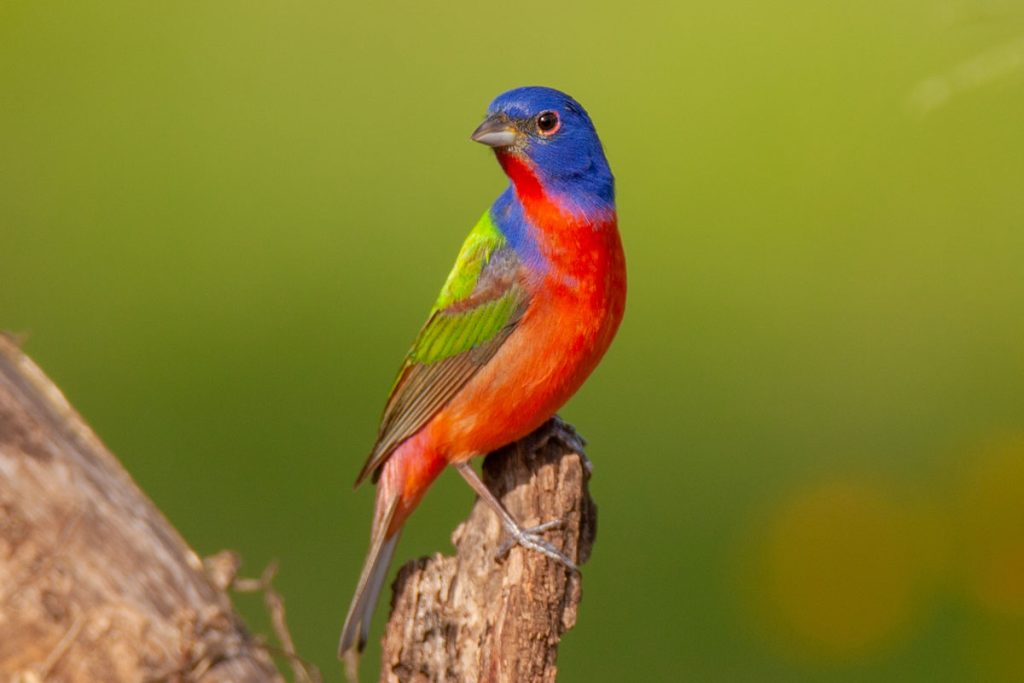
Painted Buntings can be spotted in Alabama during winter and migration. They are recorded in approximately 5% of winter checklists and 10% of checklists during migration.
Male Painted Buntings are breathtakingly colorful with vibrant blue heads, red breasts, and green backs. Females have a more subdued green coloration overall.
Scientific name: Passerina ciris
Length: 4.7-5.5 inches (12-14 cm)
Weight: 0.4-0.6 ounces (11-17 g)
Wingspan: 7.5-8.7 inches (19-22 cm)
Painted Buntings breed in the southeastern US, including Alabama, before migrating to Central America and northern South America for winter.
These buntings prefer habitats with dense vegetation, such as shrubby areas, brushy fields, and woodland edges. They primarily feed on seeds and insects.
Listen to the Painted Bunting song:
Nests of Painted Buntings are built by the females in dense shrubs or low vegetation. They are constructed from grasses, leaves, and other plant materials, forming a cup-shaped structure. The female lays around three to four eggs, which hatch after approximately two weeks. The young birds leave the nest around ten days later.
Attract Painted Buntings to your backyard with feeders containing seeds like millet and sunflower. Providing dense shrubs and bushes for cover will also increase their likelihood of visiting.
Fun Fact: Male Painted Buntings undergo a molt after the breeding season, replacing their colorful feathers with more muted plumage similar to that of females.
14. Western Kingbird
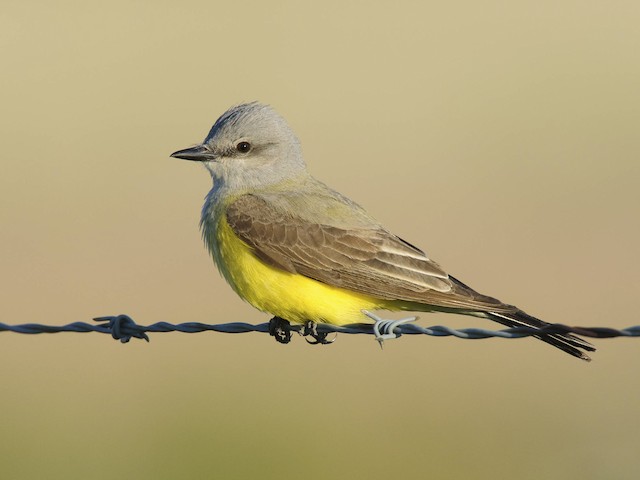
Western Kingbirds can be spotted in Alabama during migration, particularly in the spring and fall. They are recorded in approximately 3% of checklists during these periods.
Western Kingbirds have a sleek appearance with grayish-olive upperparts and pale yellow underparts. They possess a white throat and a black tail with white outer feathers.
Scientific name: Tyrannus verticalis
Length: 7.5-8.7 inches (19-22 cm)
Weight: 1.2-1.6 ounces (34-45 g)
Wingspan: 13.4-15.7 inches (34-40 cm)
Western Kingbirds breed in western US states and parts of Canada before migrating south to Mexico and Central America for winter.
These kingbirds can be found in open habitats such as grasslands, agricultural fields, and open woodlands. They primarily feed on insects, including bees, wasps, and grasshoppers.
Listen to the Western Kingbird call:
Nests of Western Kingbirds are built on horizontal branches of trees or shrubs, often near open areas. They are constructed from twigs, grass, and plant materials, forming a cup-shaped structure lined with softer materials. The female lays around four to five eggs, which hatch after approximately two weeks. The young birds leave the nest around two to three weeks later.
15. Evening Grosbeak
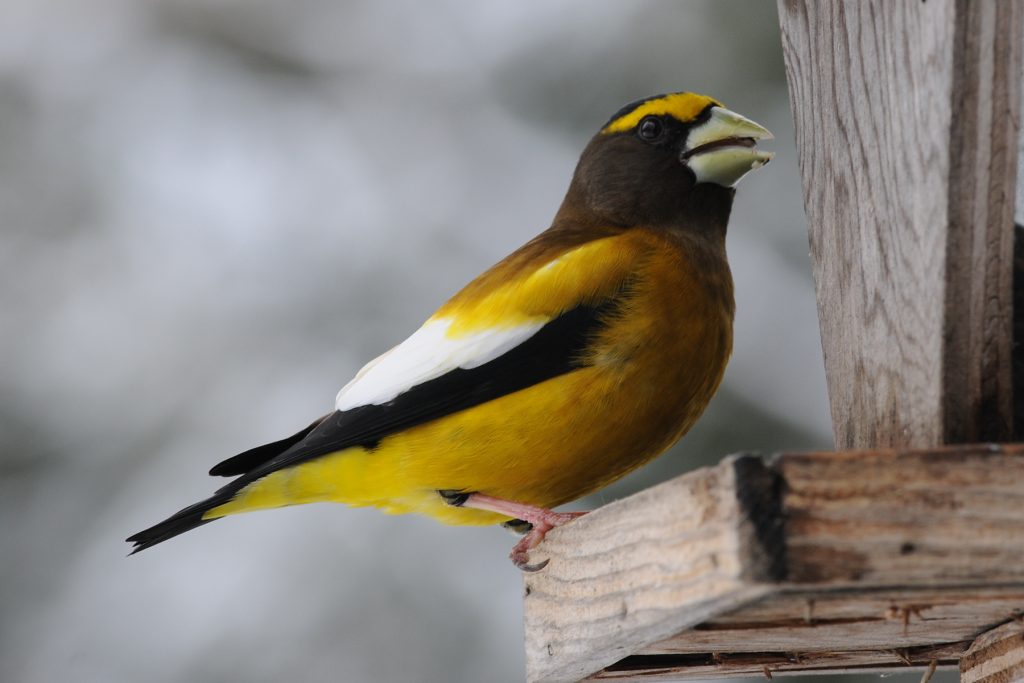
Evening Grosbeaks can be spotted in Alabama during winter and occasional irruptions. They are recorded in approximately 3% of winter checklists.
Evening Grosbeaks are large and stocky birds with bright yellow plumage, black wings, and a large, powerful beak. The males have a distinctive yellow forehead.
Scientific name: Coccothraustes vespertinus
Length: 6.7-8.3 inches (17-21 cm)
Weight: 1.6-2.3 ounces (45-65 g)
Wingspan: 11.8-13.4 inches (30-34 cm)
Evening Grosbeaks breed in coniferous forests of Canada and parts of the western US. They undertake irregular irruptions, occasionally appearing in Alabama during winter when they venture outside their typical range in search of food.
These grosbeaks can be found in various habitats, including forests, woodlands, and suburban areas. They primarily feed on seeds, especially those from coniferous trees.
Listen to the Evening Grosbeak call:
Nests of Evening Grosbeaks are constructed in trees using twigs, grass, and bark, forming a sturdy cup-shaped structure. The female lays around three to four eggs, which hatch after approximately two weeks. The young birds leave the nest around two to three weeks later.
Attract Evening Grosbeaks to your backyard with a variety of seeds, such as sunflower, safflower, and nyjer. Providing suitable trees and shrubs for nesting and cover will also increase their chances of visiting.
Fun Fact: Evening Grosbeaks have a powerful beak adapted for cracking open seeds, including those with hard shells like cherry pits.
16. American Redstart

American Redstarts can be spotted in Alabama during migration, particularly in the spring and fall. They are recorded in approximately 6% of checklists during these periods.
American Redstarts are small, active warblers with black upperparts, bright orange patches on their wings and tails, and white underparts. Females and immature birds have more subdued coloration.
Scientific name: Setophaga ruticilla
Length: 4.3-5.1 inches (11-13 cm)
Weight: 0.2-0.4 ounces (5-11 g)
Wingspan: 6.7-7.5 inches (17-19 cm)
American Redstarts breed in eastern North America, including parts of Alabama, before migrating to Central America and the Caribbean for winter.
These warblers prefer habitats such as deciduous and mixed forests, as well as wooded areas near water. They are active foragers, capturing insects on the wing.
Listen to the American Redstart song:
Nests of American Redstarts are built in the forks of shrubs or trees, often near water. They are constructed from grasses, leaves, and other plant materials, forming a cup-shaped structure. The female lays around three to five eggs, which hatch after approximately two weeks. The young birds leave the nest around ten days later.
17. Scarlet Tanager
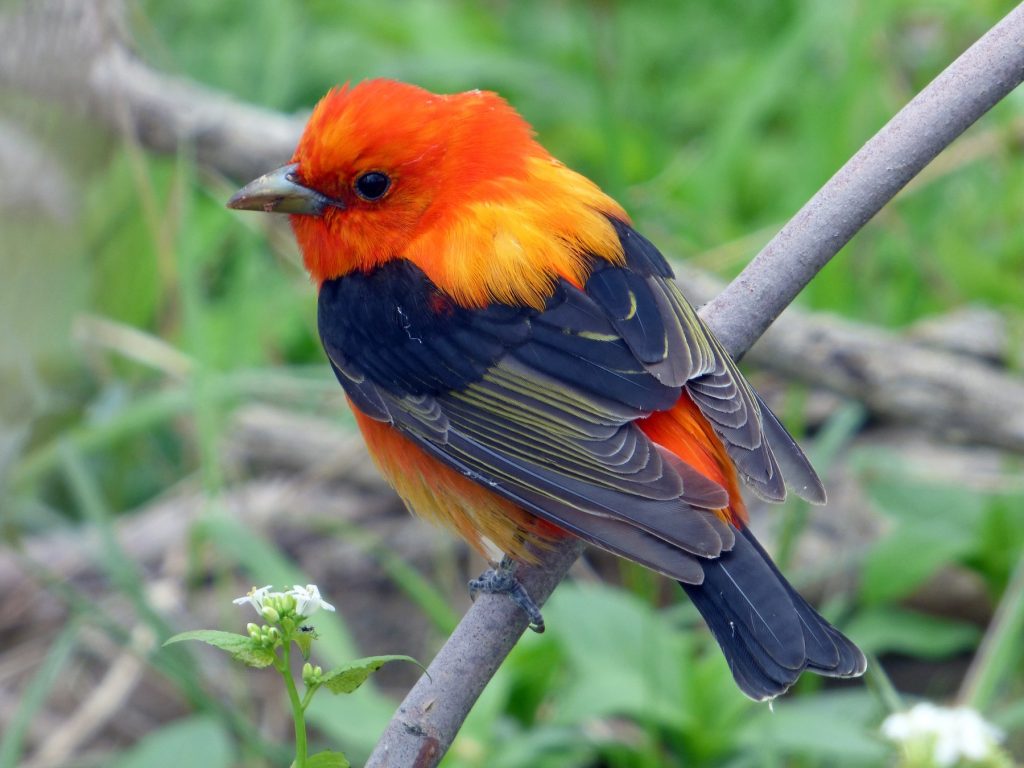
Scarlet Tanagers can be spotted in Alabama during migration, particularly in the spring and fall. They are recorded in approximately 4% of checklists during these periods.
Scarlet Tanagers are striking birds, with males exhibiting bright red plumage and black wings, while females and immature birds are yellow-green overall.
Scientific name: Piranga olivacea
Length: 6.3-7.1 inches (16-18 cm)
Weight: 1.1-1.4 ounces (30-40 g)
Wingspan: 9.8-11.4 inches (25-29 cm)
Scarlet Tanagers breed in deciduous and mixed forests of eastern North America before migrating to South America for winter.
These tanagers prefer forest habitats with a dense canopy and ample tree cover. They primarily feed on insects, as well as some fruits.
Listen to the Scarlet Tanager song:
Nests of Scarlet Tanagers are typically built in the outer branches of deciduous trees, high off the ground. They are constructed from twigs, grass, and plant materials, forming a cup-shaped structure lined with softer materials. The female lays around three to four eggs, which hatch after approximately two weeks. The young birds leave the nest around two weeks later.
Attract Scarlet Tanagers to your backyard with fruit feeders offering oranges or grape jelly. Providing tall trees and dense foliage will also increase their likelihood of visiting.
Fun Fact: Male Scarlet Tanagers undergo a molt after the breeding season, replacing their vibrant red plumage with a more olive-green coloration similar to that of females.
18. Magnolia Warbler

Magnolia Warblers can be spotted in Alabama during migration, particularly in the spring and fall. They are recorded in approximately 6% of checklists during these periods.
Magnolia Warblers are small songbirds with black upperparts, bright yellow underparts, and bold black streaking on their breasts. They feature white wing bars and a white eye ring.
Scientific name: Setophaga magnolia
Length: 4.3-5.1 inches (11-13 cm)
Weight: 0.3-0.4 ounces (9-11 g)
Wingspan: 7.1-7.9 inches (18-20 cm)
Magnolia Warblers breed in the boreal forests of Canada and parts of the northeastern US before migrating to Central America for winter.
These warblers can be found in various habitats, including coniferous and mixed forests, as well as shrubby areas. They primarily feed on insects, foraging actively in tree canopies.
Listen to the Magnolia Warbler song:
Nests of Magnolia Warblers are built on the ground, typically concealed under vegetation. They are constructed from grasses, leaves, and other plant materials, forming a cup-shaped structure lined with softer materials. The female lays around four to five eggs, which hatch after approximately two weeks. The young birds leave the nest around ten days later.
Attract Magnolia Warblers to your backyard by providing suitable vegetation and trees for cover and foraging. Insect-attracting plants can also increase their chances of visiting.
Fun Fact: Magnolia Warblers were named after the magnolia trees found near the spot where the species was first discovered.
19. Black-throated Green Warbler
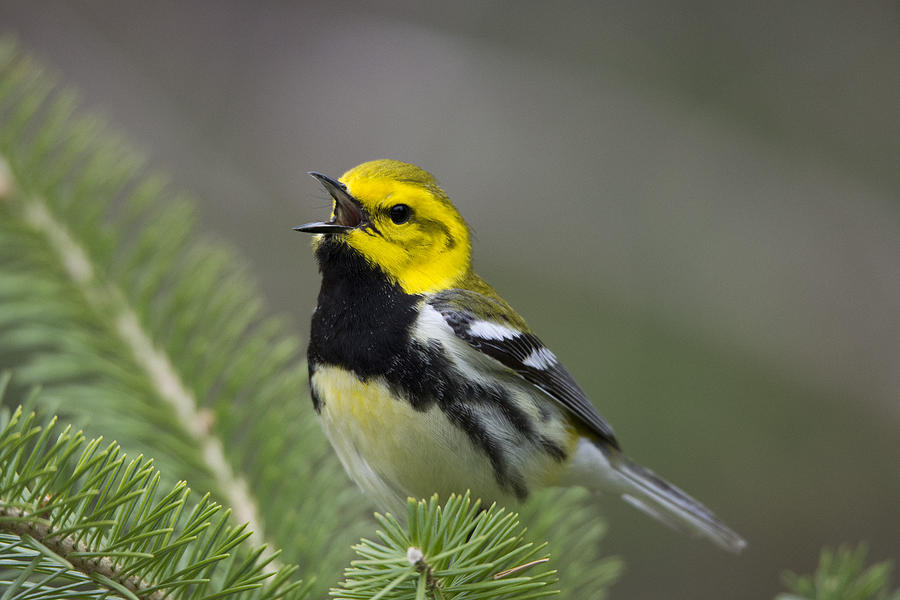
Black-throated Green Warblers can be spotted in Alabama during migration, particularly in the spring and fall. They are recorded in approximately 5% of checklists during these periods.
Black-throated Green Warblers have olive-green upperparts, bright yellow underparts, and a distinctive black throat and face. Males also exhibit black streaking on their sides.
Scientific name: Setophaga virens
Length: 4.7-5.5 inches (12-14 cm)
Weight: 0.3-0.4 ounces (9-12 g)
Wingspan: 7.5-8.7 inches (19-22 cm)
Black-throated Green Warblers breed in the boreal forests of North America before migrating to Central America and the Caribbean for winter.
These warblers can be found in a variety of habitats, including coniferous and mixed forests, as well as deciduous woodlands. They primarily feed on insects, foraging actively in tree canopies.
Listen to the Black-throated Green Warbler song:
Nests of Black-throated Green Warblers are typically built on the ground, well hidden under dense vegetation. They are constructed from grasses, leaves, and other plant materials, forming a cup-shaped structure lined with softer materials. The female lays around three to five eggs, which hatch after approximately two weeks. The young birds leave the nest around ten days later.
Attract Black-throated Green Warblers to your backyard by providing suitable vegetation and trees for cover and foraging. Insect-attracting plants can also increase their chances of visiting.
Fun Fact: Black-throated Green Warblers are known for their distinctive buzzy song that sounds like “zoo-zee, zoo-zoo-zee.”
20. Yellow Warbler
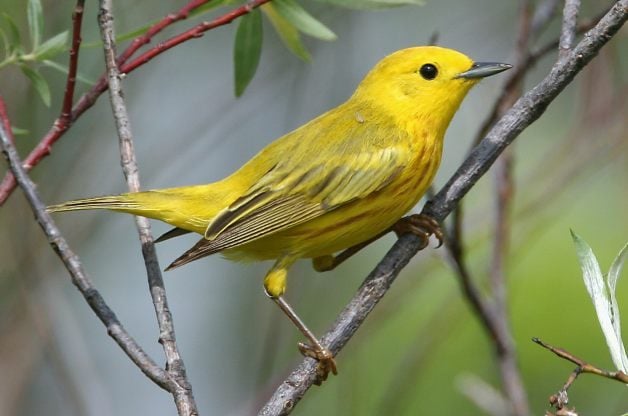
Yellow Warblers can be spotted in Alabama during migration, particularly in the spring and fall. They are recorded in approximately 7% of checklists during these periods.
Yellow Warblers are small songbirds with bright yellow plumage and contrasting rusty-red streaks on their breasts. Males also exhibit reddish streaks on their face.
Scientific name: Setophaga petechia
Length: 4.7-5.1 inches (12-13 cm)
Weight: 0.3-0.4 ounces (9-11 g)
Wingspan: 6.7-7.5 inches (17-19 cm)
Yellow Warblers breed in various habitats across North America, including parts of Alabama, before migrating to Central and South America for winter.
These warblers can be found in a variety of habitats, including wetlands, shrubby areas, and riparian zones. They primarily feed on insects, foraging actively among leaves and twigs.
Listen to the Yellow Warbler song:
Nests of Yellow Warblers are built in shrubs or trees, typically near water. They are constructed from grasses, plant fibers, and other materials, forming a cup-shaped structure lined with softer materials. The female lays around three to five eggs, which hatch after approximately two weeks. The young birds leave the nest around ten days later.
Attract Yellow Warblers to your backyard by providing suitable shrubby vegetation near water sources. Insect-attracting plants and offering mealworms or suet can also increase their chances of visiting.
Fun Fact: Yellow Warblers are known for their sweet, melodic song that sounds like “sweet, sweet, sweet, I’m so sweet.”
21. Blue-winged Warbler
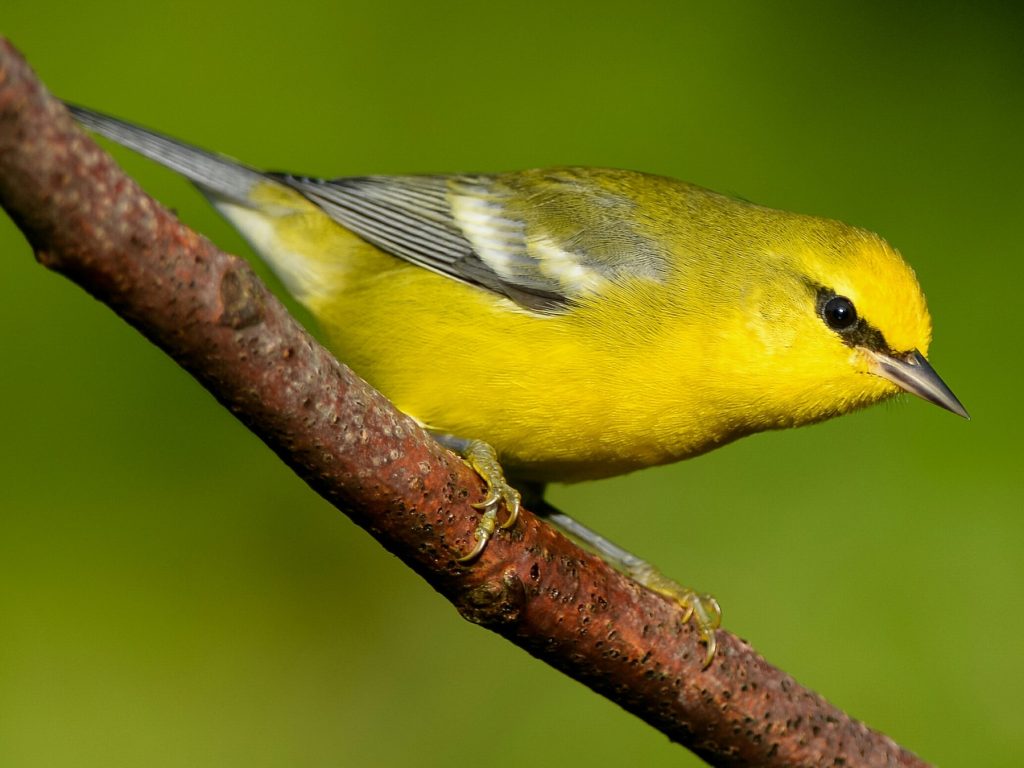
Blue-winged Warblers can be spotted in Alabama during migration, particularly in the spring and fall. They are recorded in approximately 3% of checklists during these periods.
Blue-winged Warblers have bright yellow plumage, a distinctive black eye line, and blue-gray wings. Males also exhibit a black throat patch.
Scientific name: Vermivora cyanoptera
Length: 4.7-5.5 inches (12-14 cm)
Weight: 0.3-0.4 ounces (9-12 g)
Wingspan: 7.1-7.9 inches (18-20 cm)
Blue-winged Warblers breed in the eastern United States before migrating to Central America and the Caribbean for winter.
These warblers prefer early successional habitats, such as shrubby fields, open woodlands, and regenerating forests. They primarily feed on insects, foraging actively in vegetation and trees.
Listen to the Blue-winged Warbler song:
Nests of Blue-winged Warblers are typically built on the ground, well hidden under dense vegetation. They are constructed from grasses, leaves, and other plant materials, forming a cup-shaped structure lined with softer materials. The female lays around three to five eggs, which hatch after approximately two weeks. The young birds leave the nest around ten days later.
Attract Blue-winged Warblers to your backyard by providing suitable shrubby vegetation and open spaces. Insect-attracting plants can also increase their chances of visiting.
Fun Fact: Blue-winged Warblers are known to hybridize with other warbler species, such as the Golden-winged Warbler, resulting in hybrid offspring with unique characteristics.
22. Cape May Warbler
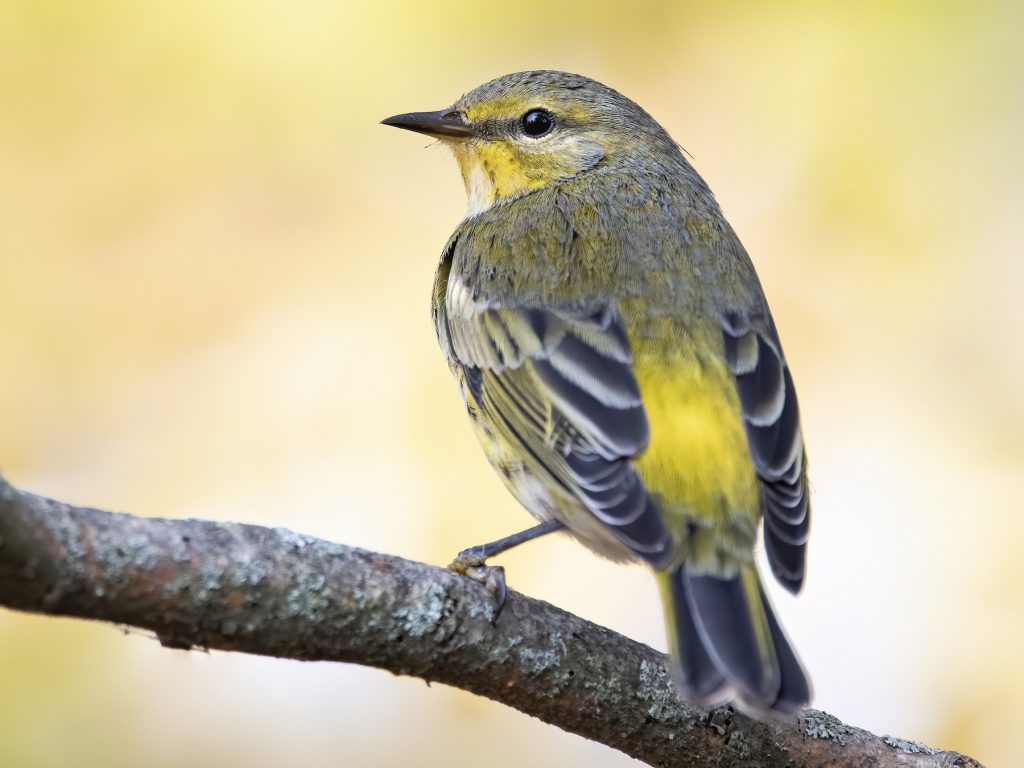
Cape May Warblers can be spotted in Alabama during migration, particularly in the spring and fall. They are recorded in approximately 4% of checklists during these periods.
Cape May Warblers have a distinctive appearance, with olive-green upperparts, yellow underparts with streaking, and a rusty-colored face patch. Males also exhibit a reddish-orange crown patch.
Scientific name: Setophaga tigrina
Length: 4.7-5.1 inches (12-13 cm)
Weight: 0.3-0.4 ounces (9-11 g)
Wingspan: 7.5-8.3 inches (19-21 cm)
Cape May Warblers breed in the boreal forests of North America before migrating to the Caribbean and Central and South America for winter.
These warblers prefer coniferous and mixed forests, as well as shrubby areas, during migration. They primarily feed on insects, including those found in tree canopies.
Listen to the Cape May Warbler song:
Nests of Cape May Warblers are typically built in coniferous trees, often at a considerable height. They are constructed from twigs, grasses, and other plant materials, forming a cup-shaped structure lined with softer materials. The female lays around four to five eggs, which hatch after approximately two weeks. The young birds leave the nest around ten days later.
Attract Cape May Warblers to your backyard by providing suitable coniferous trees and shrubby vegetation. Insect-attracting plants can also increase their chances of visiting.
Fun Fact: Cape May Warblers have a unique feeding habit during migration. They can often be observed extracting nectar from flowers, especially from the cup-shaped blossoms of the northernmost range of the tamarack tree.
23. Canada Warbler
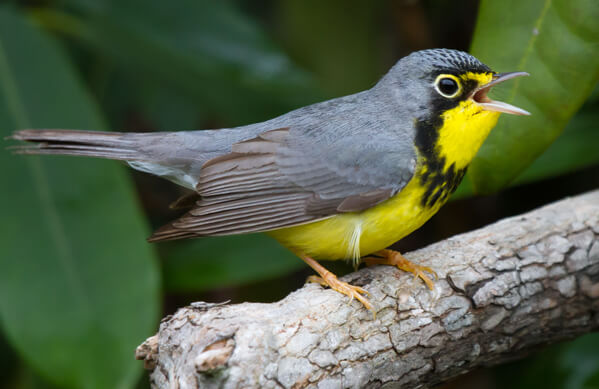
Canada Warblers can be spotted in Alabama during migration, particularly in the spring and fall. They are recorded in approximately 3% of checklists during these periods.
Canada Warblers have a striking appearance, with slate-blue upperparts, yellow underparts, and a distinctive necklace of black streaks on their chest. Males also exhibit a black throat.
Scientific name: Cardellina canadensis
Length: 4.7-5.5 inches (12-14 cm)
Weight: 0.3-0.4 ounces (9-12 g)
Wingspan: 7.5-8.3 inches (19-21 cm)
Canada Warblers breed in the boreal forests of Canada before migrating to northern South America for winter.
These warblers prefer dense, shrubby habitats, such as wetlands and regenerating forests, during migration. They primarily feed on insects, foraging actively among foliage.
Listen to the Canada Warbler song:
Nests of Canada Warblers are typically built on or near the ground, concealed under dense vegetation. They are constructed from grasses, leaves, and other plant materials, forming a cup-shaped structure lined with softer materials. The female lays around three to five eggs, which hatch after approximately two weeks. The young birds leave the nest around ten days later.
Attract Canada Warblers to your backyard by providing suitable shrubby vegetation and cover. Insect-attracting plants can also increase their chances of visiting.
Fun Fact: Canada Warblers have one of the longest migration journeys of any wood warbler, with some individuals traveling over 9,000 miles round trip between their breeding and wintering grounds.
24. Nashville Warbler
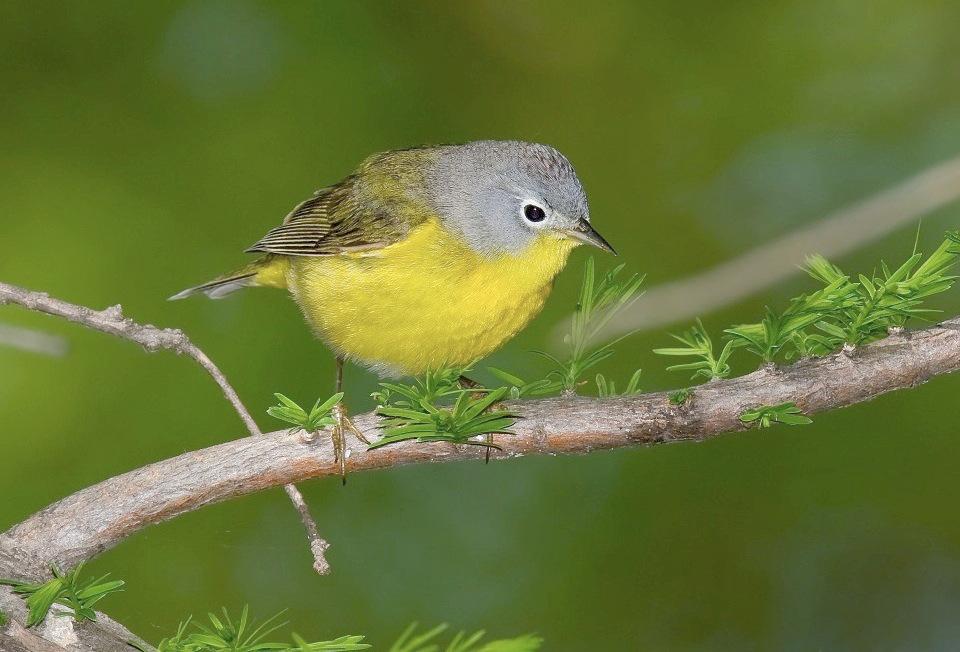
Nashville Warblers can be spotted in Alabama during migration, particularly in the spring and fall. They are recorded in approximately 3% of checklists during these periods.
Nashville Warblers have a bright yellow overall plumage with a gray head, olive-green back, and distinct white eye rings. Males also exhibit a grayish wash on their chest.
Scientific name: Leiothlypis ruficapilla
Length: 4.3-4.7 inches (11-12 cm)
Weight: 0.2-0.3 ounces (6-9 g)
Wingspan: 6.3-6.7 inches (16-17 cm)
Nashville Warblers breed in the boreal forests of North America before migrating to Central America and the Caribbean for winter.
These warblers prefer mixed forests, as well as shrubby areas, during migration. They primarily feed on insects, foraging actively among foliage and twigs.
Listen to the Nashville Warbler song:
Nests of Nashville Warblers are typically built on the ground, well hidden under dense vegetation. They are constructed from grasses, leaves, and other plant materials, forming a cup-shaped structure lined with softer materials. The female lays around three to five eggs, which hatch after approximately two weeks. The young birds leave the nest around ten days later.
Attract Nashville Warblers to your backyard by providing suitable shrubby vegetation and cover. Insect-attracting plants can also increase their chances of visiting.
Fun Fact: The Nashville Warbler was named after the city of Nashville, Tennessee, where the species was first scientifically described.
25. Wilson’s Warbler
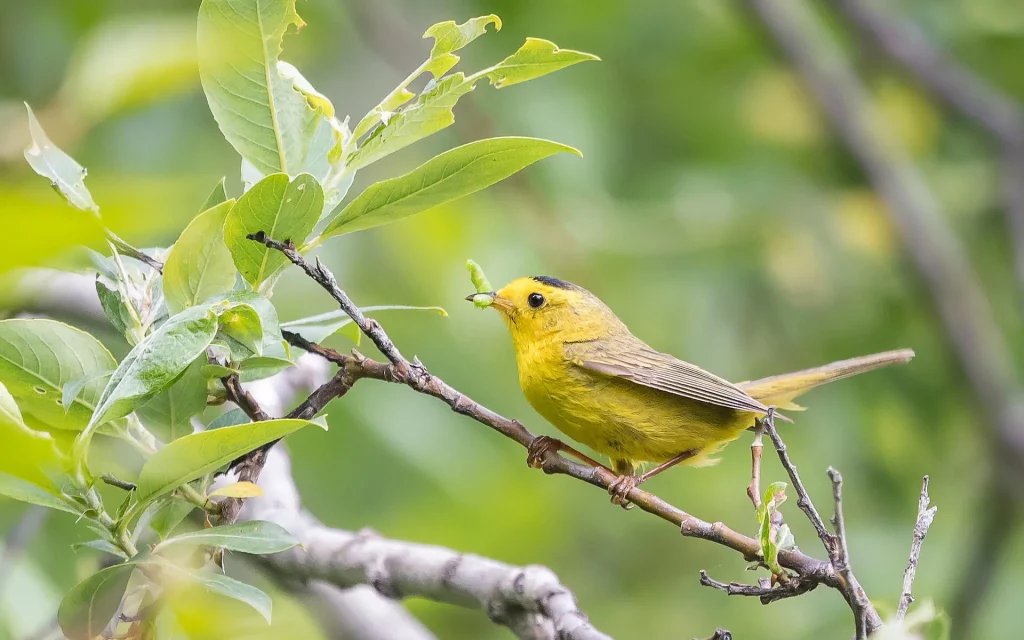
Wilson’s Warblers can be spotted in Alabama during migration, particularly in the spring and fall. They are recorded in approximately 5% of checklists during these periods.
Wilson’s Warblers have a bright yellow overall plumage with an olive-green back and distinct black caps on their heads. Males also exhibit a black patch on their throat and upper chest.
Scientific name: Cardellina pusilla
Length: 4.7-5.1 inches (12-13 cm)
Weight: 0.3-0.4 ounces (9-11 g)
Wingspan: 6.7-7.5 inches (17-19 cm)
Wilson’s Warblers breed in the western United States and parts of Canada before migrating to Mexico and Central America for winter.
These warblers prefer various habitats, including wetlands, streamside thickets, and shrubby areas, during migration. They primarily feed on insects, foraging actively among foliage and twigs.
Listen to the Wilson’s Warbler song:
Nests of Wilson’s Warblers are typically built on or near the ground, concealed under dense vegetation. They are constructed from grasses, leaves, and other plant materials, forming a cup-shaped structure lined with softer materials. The female lays around four to five eggs, which hatch after approximately two weeks. The young birds leave the nest around ten days later.
Attract Wilson’s Warblers to your backyard by providing suitable shrubby vegetation and cover. Insect-attracting plants can also increase their chances of visiting.
Fun Fact: Wilson’s Warblers are known for their constant tail-bobbing behavior, which is thought to be a visual signal to communicate with other individuals.
26. Bay-breasted Warbler
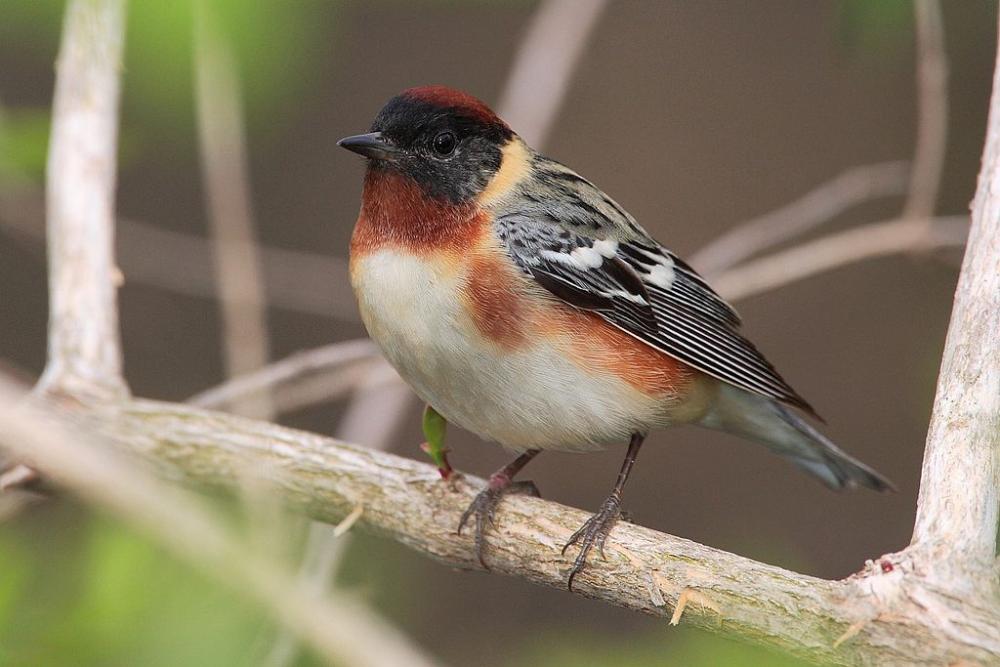
Bay-breasted Warblers can be spotted in Alabama during migration, particularly in the spring and fall. They are recorded in approximately 3% of checklists during these periods.
Bay-breasted Warblers have a unique appearance, with pinkish-brown upperparts, a chestnut-colored crown, and a streaked breast with hints of bay coloring. Males exhibit brighter and more distinct coloration.
Scientific name: Setophaga castanea
Length: 4.7-5.1 inches (12-13 cm)
Weight: 0.3-0.4 ounces (9-11 g)
Wingspan: 7.1-7.9 inches (18-20 cm)
Bay-breasted Warblers breed in the boreal forests of Canada before migrating to South America for winter.
These warblers prefer coniferous and mixed forests, as well as shrubby areas, during migration. They primarily feed on insects, foraging actively among foliage and twigs.
Listen to the Bay-breasted Warbler song:
Nests of Bay-breasted Warblers are typically built on the ground, concealed under dense vegetation. They are constructed from grasses, leaves, and other plant materials, forming a cup-shaped structure lined with softer materials. The female lays around three to five eggs, which hatch after approximately two weeks. The young birds leave the nest around ten days later.
Attract Bay-breasted Warblers to your backyard by providing suitable coniferous trees and shrubby vegetation. Insect-attracting plants can also increase their chances of visiting.
Fun Fact: The Bay-breasted Warbler is known for its long-distance migration, with some individuals traveling over 12,000 miles annually between their breeding and wintering grounds.
27. Palm Warbler

Palm Warblers can be spotted in Alabama during migration, particularly in the spring and fall. They are recorded in approximately 9% of checklists during these periods.
Palm Warblers have a distinctive appearance, with a rusty-colored cap, a yellow underbody with streaks, and a continuously wagging tail. They also have a pale throat and chest.
Scientific name: Setophaga palmarum
Length: 4.7-5.1 inches (12-13 cm)
Weight: 0.3-0.4 ounces (9-11 g)
Wingspan: 7.5-8.3 inches (19-21 cm)
Palm Warblers breed in the northern parts of North America, including parts of Alaska and Canada, before migrating to the southeastern United States, Mexico, and the Caribbean for winter.
These warblers prefer various habitats, including open woodlands, wetlands, and shrubby areas, during migration. They primarily feed on insects, foraging actively on the ground and low vegetation.
Listen to the Palm Warbler song:
Nests of Palm Warblers are typically built on or near the ground, concealed under dense vegetation. They are constructed from grasses, leaves, and other plant materials, forming a cup-shaped structure lined with softer materials. The female lays around four to five eggs, which hatch after approximately two weeks. The young birds leave the nest around ten days later.
Attract Palm Warblers to your backyard by providing suitable shrubby vegetation and open areas. Insect-attracting plants can also increase their chances of visiting.
Fun Fact: Palm Warblers are named for their habit of frequently wagging their tails, similar to the movement of a palm branch swaying in the wind.
28. Blackpoll Warbler

Blackpoll Warblers can be spotted in Alabama during migration, particularly in the spring and fall. They are recorded in approximately 5% of checklists during these periods.
Blackpoll Warblers have a relatively plain appearance, with black and white streaked upperparts and white underparts. Males exhibit a black cap during breeding season.
Scientific name: Setophaga striata
Length: 4.7-5.1 inches (12-13 cm)
Weight: 0.3-0.4 ounces (9-11 g)
Wingspan: 7.5-8.3 inches (19-21 cm)
Blackpoll Warblers breed in the boreal forests of North America before undertaking one of the longest migrations of any North American songbird. They travel to northern South America for winter.
These warblers prefer various habitats, including forests, woodlands, and shrubby areas, during migration. They primarily feed on insects, foraging actively among foliage and twigs.
Listen to the Blackpoll Warbler song:
Nests of Blackpoll Warblers are typically built on or near the ground, concealed under dense vegetation. They are constructed from grasses, leaves, and other plant materials, forming a cup-shaped structure lined with softer materials. The female lays around four to five eggs, which hatch after approximately two weeks. The young birds leave the nest around ten days later.
Attract Blackpoll Warblers to your backyard by providing suitable vegetation and cover. Insect-attracting plants can also increase their chances of visiting.
Fun Fact: The Blackpoll Warbler is known for its incredible non-stop migration across the Atlantic Ocean. Some individuals undertake a non-stop flight of over 2,000 miles from northeastern North America to South America, flying for up to 72 hours without rest.
29. Yellow-breasted Chat
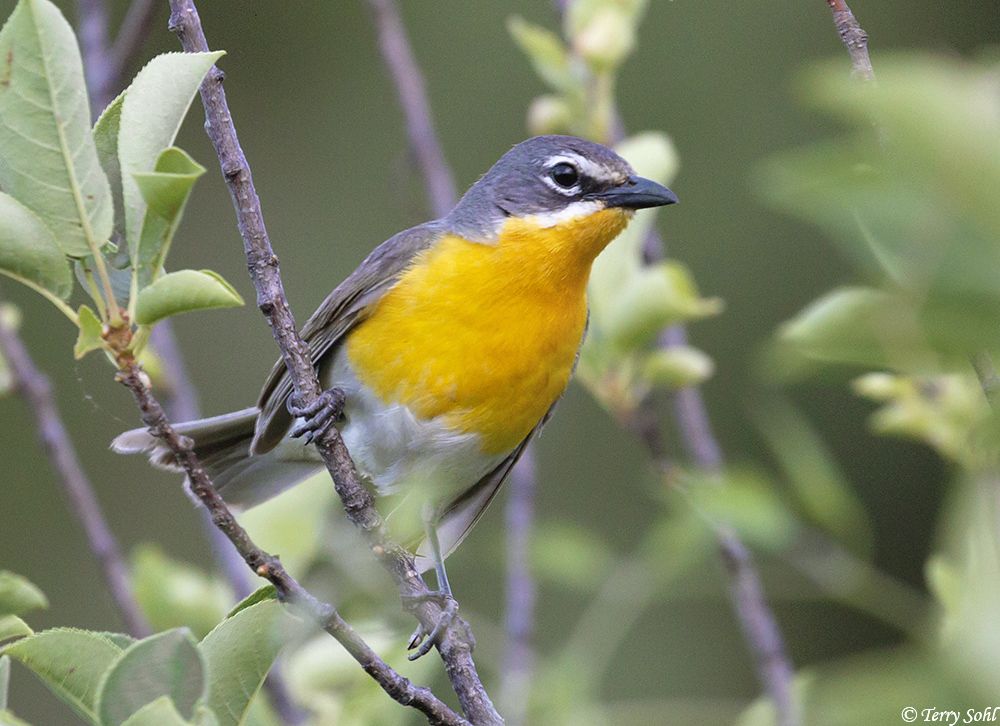
Yellow-breasted Chats can be spotted in Alabama during migration and as rare breeders. They are recorded in approximately 3% of checklists during migration periods.
Yellow-breasted Chats are large songbirds with a yellow breast and belly, olive-green upperparts, and a distinctive white eyering. They have a loud and varied song, consisting of whistles, squawks, and melodious phrases.
Scientific name: Icteria virens
Length: 6.7-7.5 inches (17-19 cm)
Weight: 1.1-1.4 ounces (31-39 g)
Wingspan: 9.8-10.6 inches (25-27 cm)
Yellow-breasted Chats breed in shrubby habitats and wetlands across the eastern and central United States before migrating to Mexico, Central America, and the Caribbean for winter.
These chats prefer dense thickets, overgrown fields, and shrubby edges of wetlands. They primarily feed on insects, foraging actively by hopping along the ground and foliage.
Listen to the Yellow-breasted Chat song:
Nests of Yellow-breasted Chats are typically built in dense shrubs or low trees, often well concealed. They are constructed from twigs, grasses, and other plant materials, forming a bulky cup-shaped structure. The female lays around three to five eggs, which hatch after approximately two weeks. The young birds leave the nest around ten days later.
Attract Yellow-breasted Chats to your backyard by providing dense shrubby vegetation and cover. Insect-attracting plants and offering mealworms or fruit can also increase their chances of visiting.
Fun Fact: Yellow-breasted Chats are known for their unique and complex vocalizations, which often include mimicry of other bird species, frogs, and even mechanical sounds.
30. Indigo Bunting
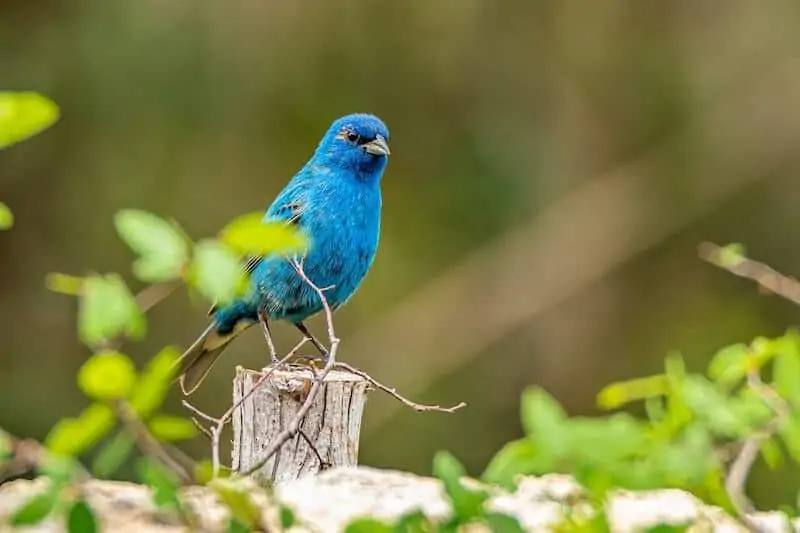
Indigo Buntings can be spotted in Alabama during migration and as breeders. They are recorded in approximately 23% of checklists during migration periods.
Indigo Buntings are small songbirds with vibrant blue plumage, deepening to indigo in males and slightly duller in females. They have short, conical bills and dark wings.
Scientific name: Passerina cyanea
Length: 4.7-5.5 inches (12-14 cm)
Weight: 0.4-0.5 ounces (11-14 g)
Wingspan: 7.5-8.3 inches (19-21 cm)
Indigo Buntings breed in open habitats across eastern and central North America, including parts of Alabama, before migrating to Mexico, Central America, and northern South America for winter.
These buntings can be found in various habitats, including fields, open woodlands, and forest edges. They primarily feed on seeds, insects, and berries.
Listen to the Indigo Bunting song:
Nests of Indigo Buntings are typically built in dense shrubs or low trees, often well concealed. They are constructed from grasses, leaves, and other plant materials, forming a cup-shaped structure lined with softer materials. The female lays around three to four eggs, which hatch after approximately two weeks. The young birds leave the nest around ten days later.
Attract Indigo Buntings to your backyard by providing suitable vegetation, bird feeders with seeds, and a water source. Offering nyjer or millet seeds can specifically attract them.
Fun Fact: The vibrant blue coloration of male Indigo Buntings is not due to pigments but is the result of light scattering by the structure of their feathers. In certain lighting conditions, they can appear black.
31. Blue Grosbeak
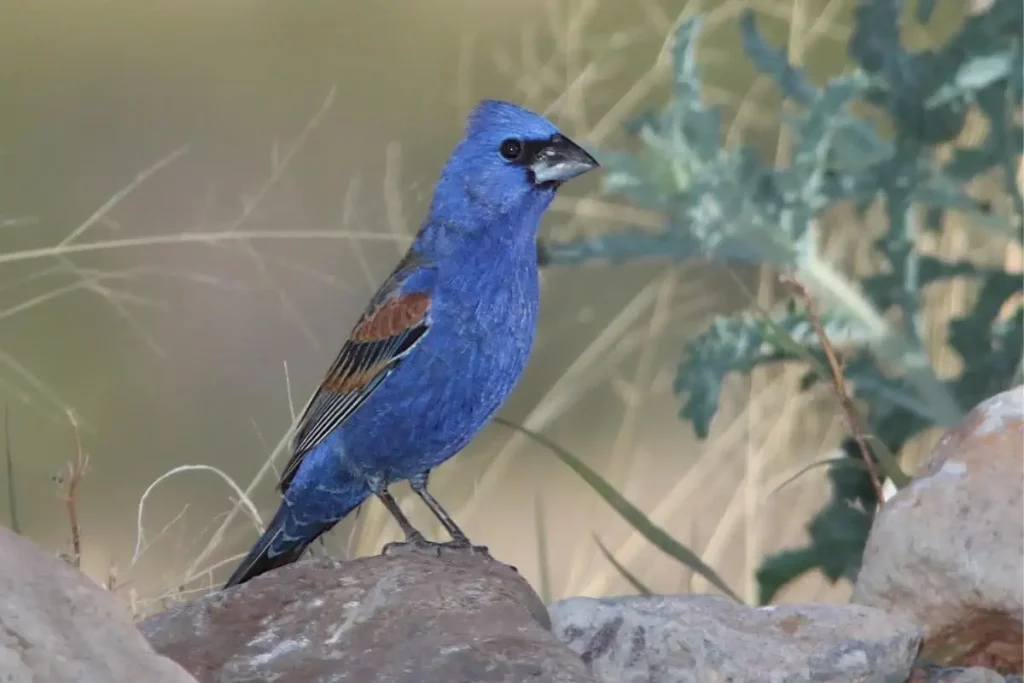
Blue Grosbeaks can be spotted in Alabama during the breeding season from April to August. They are recorded in approximately 11% of summer checklists.
Blue Grosbeaks are medium-sized songbirds with bright blue plumage in males and a brownish color in females. Males have a large silver-gray bill and black wing feathers with prominent chestnut wing bars.
Scientific name: Passerina caerulea
Length: 5.9-6.3 inches (15-16 cm)
Weight: 1.1-1.4 ounces (30-40 g)
Wingspan: 11-12 inches (28-30 cm)
Blue Grosbeaks breed across the southeastern United States and parts of Mexico before migrating to southern Mexico, Central America, and northern South America for winter.
These grosbeaks prefer habitats with open woodlands, shrubby fields, and brushy areas during the breeding season. They primarily feed on insects, seeds, and berries.
Listen to the Blue Grosbeak song:
Nests of Blue Grosbeaks are typically built in shrubs or low trees, often well concealed. They are constructed from twigs, grasses, and other plant materials, forming a cup-shaped structure lined with finer materials. The female lays around three to four eggs, which hatch after approximately two weeks. The young birds leave the nest around ten days later.
Attract Blue Grosbeaks to your backyard by providing suitable shrubby vegetation, open areas with perches, and bird feeders with seeds and insects.
Fun Fact: Blue Grosbeaks are known for their distinctive “chewink” call, which sounds similar to the call of the Eastern Towhee.
32. Rose-breasted Grosbeak
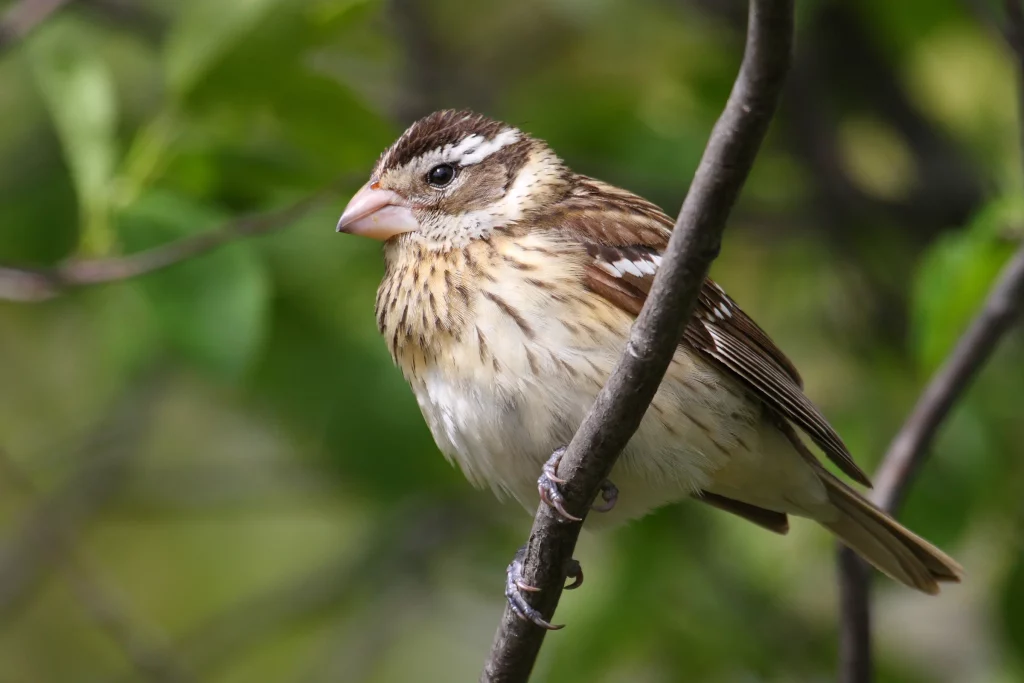
Rose-breasted Grosbeaks can be spotted in Alabama during migration and as breeders. They are recorded in approximately 14% of checklists during migration periods.
Rose-breasted Grosbeaks are medium-sized songbirds with striking plumage. Males have black upperparts, a white belly, and a bright rose-red breast patch. Females have a brownish and heavily streaked appearance.
Scientific name: Pheucticus ludovicianus
Length: 7-8.3 inches (18-21 cm)
Weight: 1.5-1.9 ounces (42-54 g)
Wingspan: 11-12.2 inches (28-31 cm)
Rose-breasted Grosbeaks breed in the eastern and central parts of North America, including parts of Alabama, before migrating to Central America and northern South America for winter.
These grosbeaks can be found in various habitats, including woodlands, forest edges, and gardens. They primarily feed on insects, fruits, and seeds.
Listen to the Rose-breasted Grosbeak song:
Nests of Rose-breasted Grosbeaks are typically built in trees, often well concealed. They are constructed from twigs, grasses, and other plant materials, forming a cup-shaped structure lined with finer materials. The female lays around three to five eggs, which hatch after approximately two weeks. The young birds leave the nest around ten days later.
Attract Rose-breasted Grosbeaks to your backyard by providing suitable vegetation, bird feeders with seeds and fruits, and a water source.
Fun Fact: Male Rose-breasted Grosbeaks are known for their melodious and rich warbling songs, which they often sing from prominent perches.
33. Eastern Bluebird

Eastern Bluebirds can be spotted in Alabama throughout the year, but they are more commonly seen during the breeding season. They are recorded in approximately 34% of checklists during the breeding season.
Eastern Bluebirds are small thrush-like songbirds with bright blue upperparts and a rusty-colored throat and breast in males. Females have a more subdued coloring with grayer upperparts and a pale blue tint on the wings and tail.
Scientific name: Sialia sialis
Length: 6.3-8 inches (16-20 cm)
Weight: 1-1.1 ounces (28-32 g)
Wingspan: 9.8-12.2 inches (25-31 cm)
Eastern Bluebirds breed across eastern North America, including parts of Alabama. Some individuals may migrate south during the winter, while others remain in their breeding territories.
These bluebirds can be found in various habitats, including open woodlands, meadows, and parks. They primarily feed on insects and small fruits.
Listen to the Eastern Bluebird song:
Nests of Eastern Bluebirds are typically built in natural cavities, tree cavities, or specially designed nest boxes. They are constructed from grasses, pine needles, and other fine materials, forming a cup-shaped structure lined with softer materials. The female lays around three to seven eggs, which hatch after approximately two weeks. The young birds leave the nest around three weeks later.
Attract Eastern Bluebirds to your backyard by providing suitable nest boxes with proper specifications, open areas with perches, and offering mealworms or suet.
Fun Fact: Eastern Bluebirds are cavity nesters but often rely on human-provided nest boxes, as natural cavities have become scarce due to habitat changes and competition from other bird species.
34. American Robin

American Robins can be spotted in Alabama throughout the year, but they are more commonly seen during the breeding season. They are recorded in approximately 48% of checklists during the breeding season.
American Robins are medium-sized thrushes with gray-brown upperparts, a reddish-orange breast, and a white belly. They have a distinctive blackish head and a yellow bill.
Scientific name: Turdus migratorius
Length: 9-11 inches (23-28 cm)
Weight: 2.7-3 ounces (77-85 g)
Wingspan: 12.2-15.8 inches (31-40 cm)
American Robins breed across North America, including parts of Alabama, before some individuals migrate south during the winter, while others remain in their breeding territories.
These robins can be found in various habitats, including woodlands, gardens, and suburban areas. They primarily feed on earthworms, insects, and fruits.
Listen to the American Robin song:
Nests of American Robins are typically built on tree branches, building ledges, or other structures. They are constructed from grasses, twigs, and other plant materials, forming a cup-shaped structure lined with mud and finer materials. The female lays around three to five eggs, which hatch after approximately two weeks. The young birds leave the nest around two weeks later.
Attract American Robins to your backyard by providing suitable nesting locations, open areas with short grass for foraging, and offering mealworms or fruits.
Fun Fact: American Robins are known for their melodious and cheerful songs, often heard early in the morning as they herald the arrival of a new day.
35. Northern Mockingbird
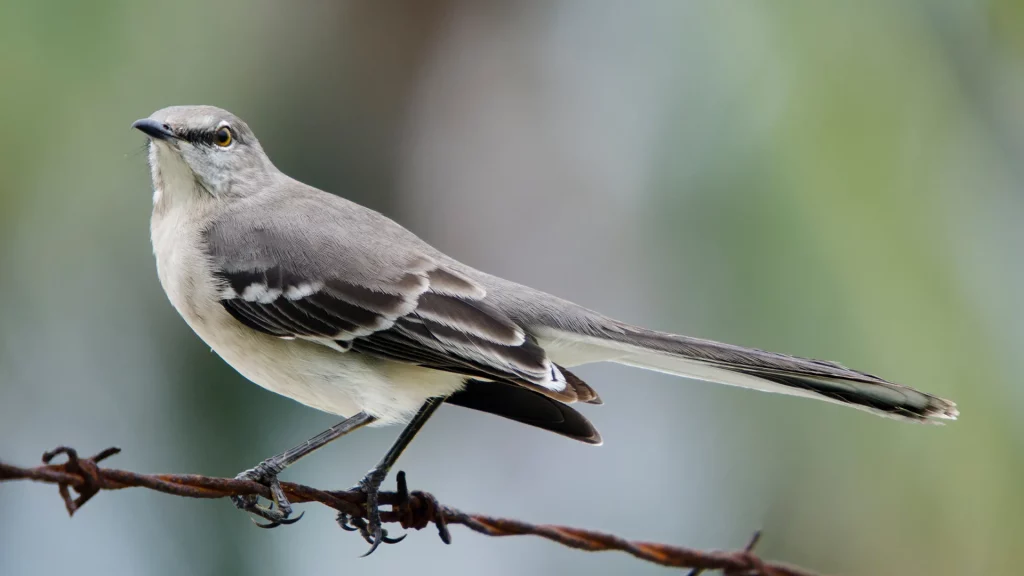
Northern Mockingbirds can be spotted in Alabama throughout the year, as they are resident birds in the state. They are recorded in approximately 59% of checklists throughout the year.
Northern Mockingbirds are medium-sized songbirds with a grayish-brown plumage, a white belly, and white wing patches. They have long tails and a slender bill.
Scientific name: Mimus polyglottos
Length: 8.3-10.2 inches (21-26 cm)
Weight: 1.6-2 ounces (45-58 g)
Wingspan: 12.2-13.4 inches (31-34 cm)
Northern Mockingbirds are resident birds across the southeastern United States, including Alabama. They do not migrate and can be found in a variety of habitats, including open woodlands, suburban areas, and gardens.
These mockingbirds primarily feed on insects, fruits, and berries. They are also known for their remarkable ability to mimic the songs of other bird species and various sounds in their environment.
Listen to the Northern Mockingbird song:
Nests of Northern Mockingbirds are typically built in shrubs, trees, or other vegetation. They are constructed from twigs, grasses, and other plant materials, forming a cup-shaped structure lined with softer materials. The female lays around three to five eggs, which hatch after approximately two weeks. The young birds leave the nest around two weeks later.
Attract Northern Mockingbirds to your backyard by providing suitable vegetation, open areas with perches, and offering a variety of food sources, including insects, fruits, and suet.
Fun Fact: Northern Mockingbirds are known for their territorial behavior and remarkable vocal abilities. They can imitate the songs of dozens of bird species and even mimic sounds such as sirens and car alarms.
36. Brown Thrasher
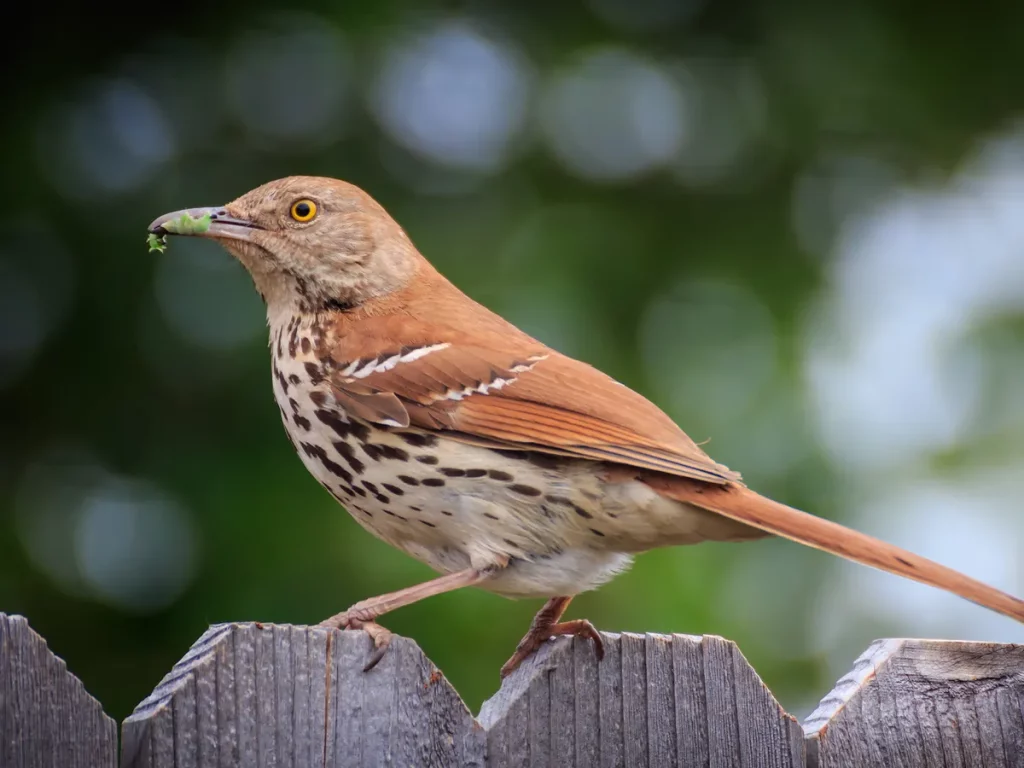
Brown Thrashers can be spotted in Alabama throughout the year, as they are resident birds in the state. They are recorded in approximately 26% of checklists throughout the year.
Brown Thrashers are medium-sized songbirds with a reddish-brown plumage, a white belly with dark streaks, and a long, downward-curved bill. They have bright yellow eyes.
Scientific name: Toxostoma rufum
Length: 9.8-11.8 inches (25-30 cm)
Weight: 2.3-3.1 ounces (65-88 g)
Wingspan: 11.8-12.6 inches (30-32 cm)
Brown Thrashers are resident birds across the eastern United States, including Alabama. They do not migrate and can be found in various habitats, including woodlands, scrublands, and suburban areas.
These thrashers primarily feed on insects, earthworms, fruits, and berries. They use their long bills to probe the ground for prey.
Listen to the Brown Thrasher song:
Nests of Brown Thrashers are typically built in dense shrubs, low trees, or vine tangles. They are constructed from twigs, grasses, and other plant materials, forming a cup-shaped structure lined with softer materials. The female lays around three to five eggs, which hatch after approximately two weeks. The young birds leave the nest around two weeks later.
Attract Brown Thrashers to your backyard by providing suitable vegetation, offering a variety of food sources, including insects, fruits, and mealworms, and creating brush piles for cover.
Fun Fact: Brown Thrashers are known for their complex and varied song repertoire, with each individual often having its own unique variations and improvisations.
37. Gray Catbird
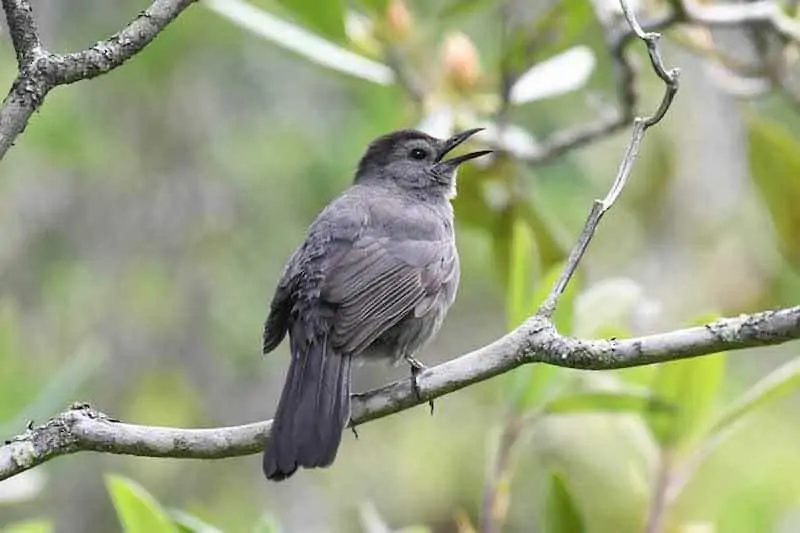
Gray Catbirds can be spotted in Alabama throughout the year, as they are resident birds in the state. They are recorded in approximately 41% of checklists throughout the year.
Gray Catbirds are medium-sized songbirds with a solid gray plumage, a black cap on the head, and a long, black tail. They have a black bill and dark eyes.
Scientific name: Dumetella carolinensis
Length: 8.3-9.1 inches (21-23 cm)
Weight: 0.8-1.5 ounces (23-43 g)
Wingspan: 8.7-9.8 inches (22-25 cm)
Gray Catbirds are resident birds across the eastern and central parts of North America, including Alabama. They do not migrate and can be found in various habitats, including woodlands, thickets, and gardens.
These catbirds primarily feed on insects, fruits, and berries. They are known for their mewing or cat-like calls, which give them their name.
Listen to the Gray Catbird song:
Nests of Gray Catbirds are typically built in dense shrubs, small trees, or vine tangles. They are constructed from twigs, grasses, and other plant materials, forming a cup-shaped structure lined with softer materials. The female lays around two to six eggs, which hatch after approximately two weeks. The young birds leave the nest around two weeks later.
Attract Gray Catbirds to your backyard by providing suitable vegetation, offering a variety of food sources, including insects, fruits, and berries, and providing water sources such as birdbaths.
Fun Fact: Gray Catbirds are excellent mimics and can imitate the songs of other bird species, as well as various sounds in their environment, such as squeaky gates and car alarms.
